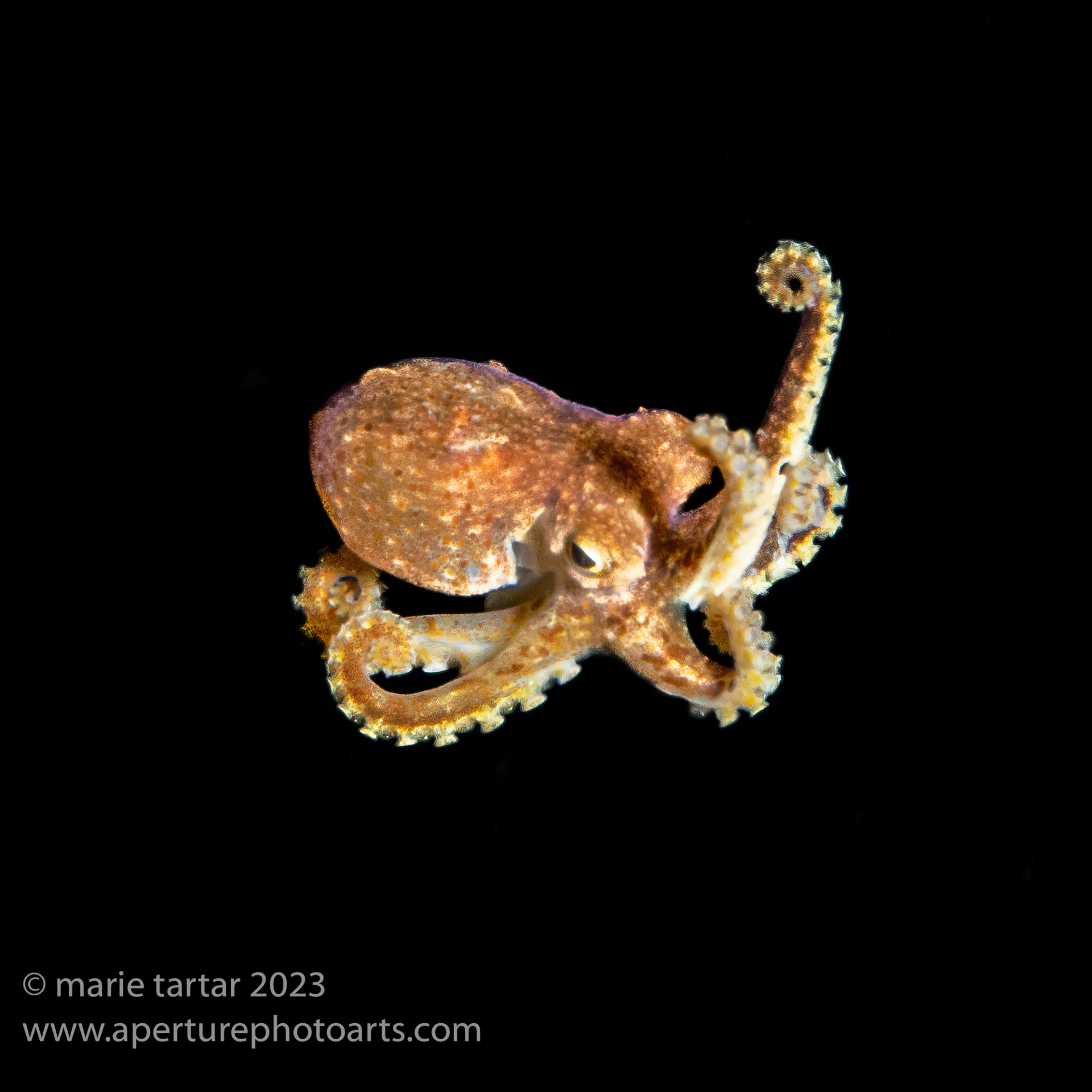
Scuba diving has taken us around the world, but never, until recently, had we ventured into outer space. At least that is what it felt like, entering the strangely wonderful world of blackwater underwater photography, a realm of marvelous and often microscopic creatures, drawn to the surface from the ocean’s depths in the nightly phenomenon of the diel vertical migration. Although this occurs naturally every night, the process is concentrated by hanging lights in deep water. It has even been observed during transient phenomena, like a total solar eclipse.
Shining a light into a thick fog of plankton, we searched for floating apparitions of the night, denizens of the deep, part of a mass vertical migration from darkness at depth towards the surface and light, avoiding predation by day and feeding by night. Blackwater underwater images had intrigued us in recent years, but we’d never had a chance to try it ourselves. When I saw back in the spring of 2023 that Alex Mustard was hosting a workshop dedicated to blackwater in Anilao, Philippines, I jumped on it, nabbing the last 3 spaces for Steve, Greg and myself. This was just after returning from our Silfra workshop in Iceland with Alex in April 2023. We’d been to the Philippines just once before, in 2016, a wonderfully productive week of muck diving, also in Anilao.
Saturday, November 18-Monday, November 20, 2023
It’s a very loooong travel day indeed that ends two days later. For us, this was ultimately 24 hours, including 2 hours transit to LAX by car, 3 planned hours at LAX, 2.5 additional unplanned hours waiting due to the delayed arrival of our plane, all before finally embarking on the 15 hour non-stop Philippines Airlines flight itself. Our scheduled 10:30 pm evening departure left all day for additional packing, on top of the seemingly endless preparations over the preceding week. Steve had 2 weekdays off and I had a record 4 to prepare, but somehow the week flew by as I labored simultaneously to thin my bulging closet, coordinate home repairs (including an unexpected leak in the kitchen, heralded by a buckled wooden floorboard in front of the sink), ordered a new dishwasher, had hair and nails done, saw the hand surgeon for a final visit (an untimely wrist fracture after an accident with my mountain bike exactly 8 weeks before put this trip in jeopardy) and everything else one crams into weekdays off.
Our economy seats ($2200 value) on the non-stop LAX-Manila Philippines Airlines flight were essentially free, thanks to accumulated Chase Sapphire points, costing us $66 and 142,000 points. Of course, the thrill of free airline tickets was offset by the prospect of 15 hours in coach. After failing in our bid to upgrade, we settled at check in for paying $120 extra per person for extra legroom bulkhead seats. Steve discovered his Peak Design bag was exactly the right height and stiffness to serve as a footrest.
Greg was already en route, flying through Tokyo. While waiting in LAX, we received a panicked text from him: Does Steve has his Nikon Z8 with him? Greg had accidentally packed his Z7 instead of the Z8. Camera housings are so highly specific to particular camera makes and models that this error would keep him from shooting at all. He had already decided having his Z8 shipped from Chicago would cost too many days of lost shooting and decided to extend his layover in Tokyo to procure another body.
I finally had a chance to see a recommendation from our friend Joe, Empire of Light, written and directed by Sam Mendes, starring a brilliant Olivia Colman. Set in the early 1980s in a seaside English village, it depicts the lives of the staff of the Empire Cinema, an art deco movie palace. What theme doesn’t this affecting film touch on? Race relations, sexual harassment, the nature of friendship, mental health struggles, to name a few.
I followed this up with a comedy, the entertaining Jerry & Marge Go Large with Bryan Cranston, Annette Bening, Rainn Wilson and Ann Harada, based on a true story of a retired mathematician who recognizes a flaw in certain type of lottery which can be reliably exploited, IF one has sufficient capital to change the odds.
The final leg of our journey, the 2 hour drive to Crystal Blue Resort, has been markedly improved by the opening of a new bridge and road since our prior trip here in 2016. Then, construction made our transfer 5 traffic-snarled, crawling hours long.
Arriving a day early left us plenty of time to unpack, build our underwater cameras and for me, to have a glorious massage to undo the hours of travel and lost sleep.
Tuesday, November 21, 2023
Delayed by a day while procuring a new camera body in Tokyo, Greg made it in to the resort around midnight, I learned by text in the morning. We had crashed early the night before.
Although the original plan was to do a single afternoon dive and 2 blackwater night dives each day, the uncertainty of when trip leader Alex would arrive in the afternoon today led us to decide to do a 2-tank dive in the morning. This first foray into the water was fraught with more than the usual amount of anxiety for me, just over 8 weeks after fracturing my wrist and with the aftermath of a head cold still causing an occasional barking cough. Could I pull my new 5 mm Henderson Aqua-lock Quick-dry wetsuit on without stressing my wrist too much? How much weight would it take to sink this uncompressed wetsuit? Could I manage the camera without loading my wrist too much? Had I recovered from my recent cold enough to even dive? All of these questions were answered in the first dive. 16 pounds was not quite enough to sink me and the wetsuit, but with 2 additional pounds deposited in my pocket, I was able to submerge. Unfortunately, this made me a little lopsided, which was tricky to manage on the mucky slope. I ditched the extra weight after the first dive and had no problem descending on the second without it.
Steve and I were paired with Rob and Pash, experienced divers from the south coast of the UK. Our guide Jomel produced subject after subject: tiny shrimps and crabs, minuscule frogfish, a wisp of a flamboyant cuttlefish (being eyed by a flounder).
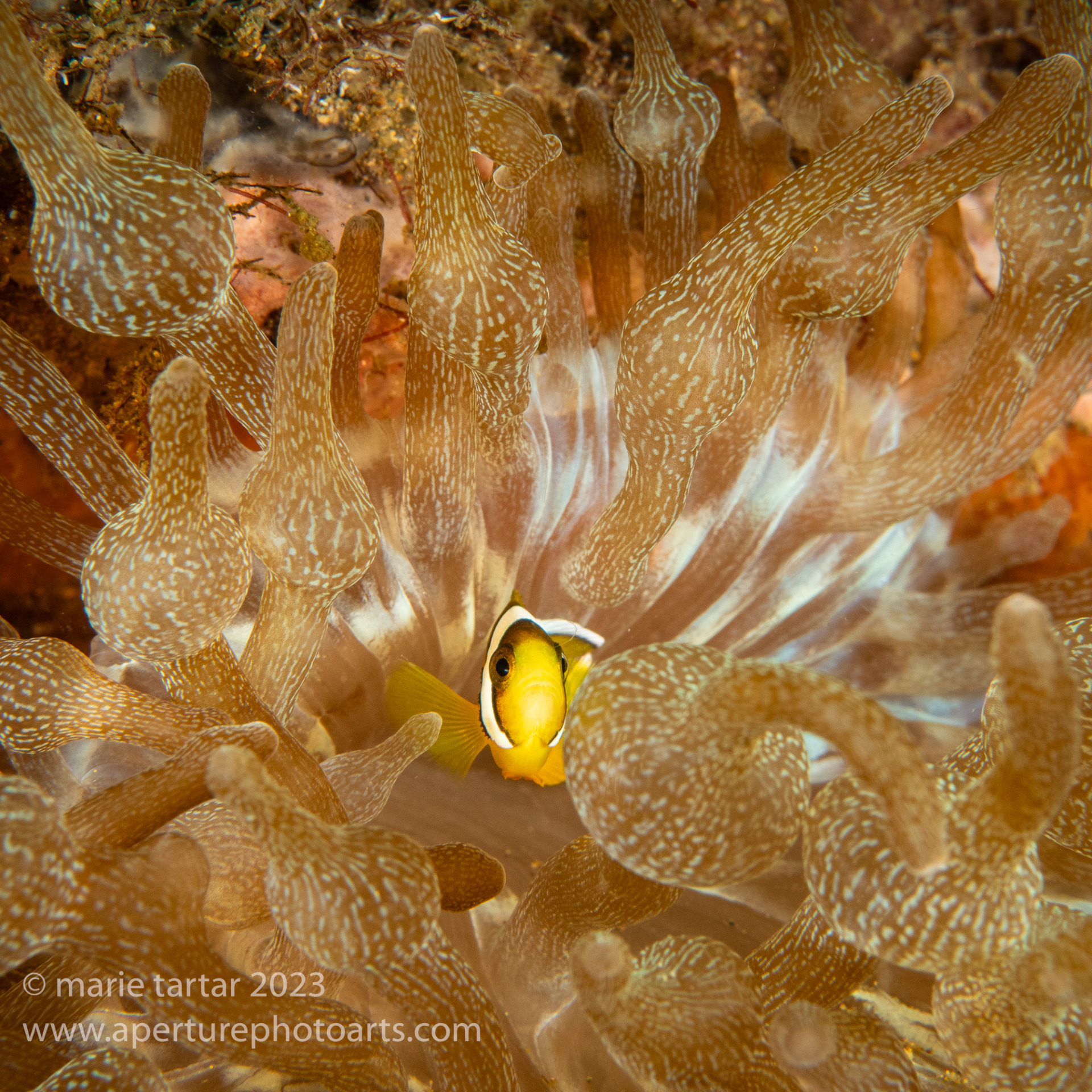
A tiny anemone fish at home in an exceptionally gorgeous bubble-tipped anemone (Entacmaea quadricolor), Anilao, Philippines.

Ambon scorpionfish (Pteroidichthys amboinensis), named for another famous muck diving site in Indonesia, on the sand in Anilao, Philippines.
61 min 83 feet (El Pinoy)
59 min 75 feet (house reef)
Meanwhile, Greg was thinking he had been sold a bum Z8.
Greg: “How good is your Japanese?”
Me: “Sukoshi hanashimasu.” (I speak a little.)
He presented me with an LED screen filled with Japanese characters. I could make out part of the last of 3 lines. Kudasai, or please (do something).
An idea occurred to him, maybe it was asking him to put in a memory card. He dashed off. Back in our room, I relayed Greg’s troubles to Steve. He suggested I could take a screenshot and send it to my cousin In Japan for translation. Before that became necessary, a dormant internal battery came to life and seeing the globe symbol, we were able to switch the text to English.
At the orientation by Alex at 5:30 pm, the proposed schedule for the week’s workshop was set out: After lunch at approximately 12:30, the teaching sessions would follow. This left time for a 3 pm day dive, with dinner at 6 pm (earlier than the resort’s usual 7 pm), with departures for 2 blackwater night dives at 7 pm.
My first blackwater dive was indeed a very black, not pleasant at all, experience for me. Diving over a deep (hundreds of feet) ocean, without a safely reachable reef or bottom, a line is strung with strong video lights every 15 feet or so, down to a weight at 75 feet. This is suspended from a glowing orange float called a pumpkin, which is allowed to roam freely with wind and current. This is how our boat driver tracks and follows us in the water, as we keep the line in sight, it being our only visual reference for depth. Try as I might, no matter how much air I introduced into my BCD, I could not achieve neutral buoyancy and had to kick constantly to maintain a depth above 50 feet. Accordingly, I stayed close to the line, close enough to grab it if necessary. Meanwhile the others were zipping around deeper and on the periphery of the line’s illumination and on our surface interval, I was treated to their accounts of passing wonders.
It turned out my BCD was indeed losing air as fast as I could introduce it, at the connection to the vest, as we discovered and remedied during our surface interval.
Thankfully, my second blackwater dive was as different from the first as night and day. It was easy to establish neutral buoyancy and more comfortable to stay away from the jerking line and glaring intensity of its lights. Jomel’s frantic waving of his torch made us converge on him and a tiny translucent wunderpus octopus.

Yes, our boat (Steve and me, with Rob and Pash, led by Jomel) lucked out on our very first blackwater dive evening. While it is tricky to signal a find on this kind of dive, Jomel’s flashing light communicated clearly enough. The larval wunderpus (scientific name, wunderpus photogenicus) is a tiny, alien-looking, translucent marquee critter of the blackwater world.
65 min 78 feet
63 min 86 feet
Wednesday November 22, 2023
We decided against adding on a morning dive, in case we wanted to make up for lost sleep. Nevertheless, I woke up at 6:30 am despite best intentions and crept down the steep stone staircase to download from the prior night. With a newly healed wrist fracture, avoiding injury was priority number one. Having the morning free left time for a 90 minute massage just before lunch, after which Alex did a presentation on blackwater techniques.
I was surprised to learn most blackwater shots are heavily cropped and have a lot of backscatter, requiring significant clean up. The backscatter is inevitable, as it is the density of plankton in the waters that attracts the migratory and larval forms of life we seek.
Alex’s presentation gave us lots of good pointers to set us up for blackwater success. Being a skilled diver and stable in the water is key, not just for safety but to be able to successfully find and focus on our subjects, many of which are tiny and easily displaced by moving too quickly and creating a bow wave. Some subjects are hard to focus on because they come too close, being attracted by our lights. We were advised to be neutrally buoyant and to move slowly. Alex adds a buoyancy collar to his rig to make it close to neutral for blackwater diving. Lens selection favors a wider macro lens over a longer focal length, being easier to focus, shooting with a plan to crop. For my Panasonic GH5 micro 4/3rd mirrorless system, I brought a 30 mm macro lens, roughly equivalent to the Nikon 60 mm macro lens Steve brought to use with his Nikon D850. When I bought this system from Kevin at Reef Photo back in 2019, he mentioned the 30 mm as ideal for blackwater, if that interested me. It did but who knew a global pandemic would keep me from trying blackwater for 4 years?!
Some people mount their focusing light underneath their housing. Steve tried this and it worked well for him, but when we converged on especially interesting subjects, I was near blinded.
Alex mounts his strobes on medium length arms, with the lights about shoulder width apart. Depending on the subject, he directs them forward (particularly for a large, more “solid” subject like a batfish he found one night) or might push them forward and point them inward towards each other to light a translucent subject. He has Retra strobes and uses them with beam restrictors on half power without diffusers. Conversely, Mike prefers the light quality emanating from his Sea & Sea strobes to be diffused.
Alex’s suggested “jump settings” are a small aperture (f18-20), shutter speed of 1/250 or strobe sync speed (effectively, shutter speed doesn’t matter, as there is no ambient light). He varies the ISO from lower for reflective subjects (200) to higher for translucent subjects (640), generally starting around 320 and adjusting as needed. Alex turns off image review while shooting blackwater. While Mike prefers back button focusing, Alex does not use it when shooting in blackwater. An option to consider is slow continuous shooting, 1-2 frames/second (if one’s strobes can recycle that quickly). Alex suggested using single central continuous auto-focus. Finally, he touched on some possibilities for more artistic, slow shutter speed panning shots, with speeds down to 1/10, with the animal’s motion frozen by front curtain flash and motion produced by panning the camera after depressing the shutter.
He also discussed processing techniques for blackwater, using a combination of dialed down clarity, texture, highlights and finally, exposure, in that order, after the background is selected.
Alex mentioned he had seen multiple male argonaut pelagic octopi the night before and recommended carefully surveying passing salps, as the miniature octopi closely mimic the orange blobs which dot the chains of planktonic tunicates. After learning this, I looked hard at each passing train of salps sailing past for any “extra” orange bumps which interrupted the even spacing of the orange organelles. It took me a few nights before I clearly saw the eye of a passing argonaut hitching a ride on a salp train.
Salps proved to be one of the largest and most frequently seen creatures we saw. At times, they were so numerous it seemed we were surrounded by swirling snakes. Sometimes they sped past us quickly like so many speeding subway cars, while others would wrap themselves around our camera’s arms and brush against our faces, a creepy sensation (they resemble jellyfish but are surprisingly firm to the touch). Space X also came to mind-the one time I saw this train of satellites was on a very dark night in the Grand Canyon, when I was setting up for a Milky Way shot and was startled by a train of lights which I initially took to be Santa’s sleigh, electrified.
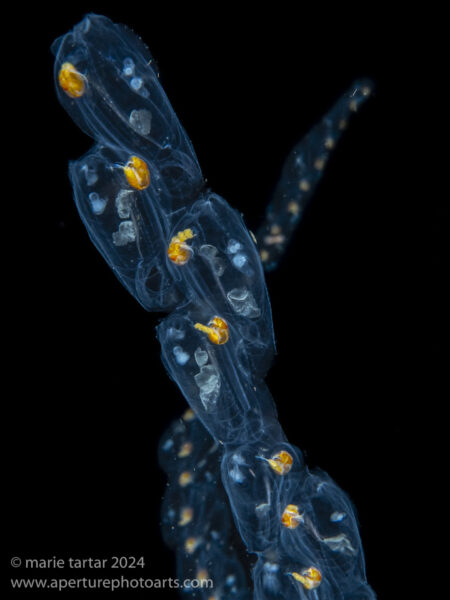
One of the most common creatures we encountered diving Anilao’s blackwater: salps! Long chains of these unicellular colonial tunicates raced in and around us, zipping past us like speeding trains.
The sensation of being in an entirely alien world is amazing. I can only liken it to what I imagine being in outer space must feel like, floating untethered, at times lying down on a cloud, observing the close up drama and activity of the miniscule particles and animals illuminated by our lights, while searching through the fog with our narrow beam light sabers for reflections which might signify larger animals of interest.
We did manage to make it out for an afternoon dive, ours being to El Pinoy (63 min 83 feet), where Jomel found us tiny oblong shrimp, many miniature crabs and shrimp on sea pens, as well as a pair of emperor shrimp on the exposed anus of a sea cucumber, mostly buried in sand.

Sea pen shrimp, Anilao, Philippines.
Our two blackwater dives were in a thick plankton soup, with slithery salps snaking through the fog. An occasional jellyfish appeared in the gloom.
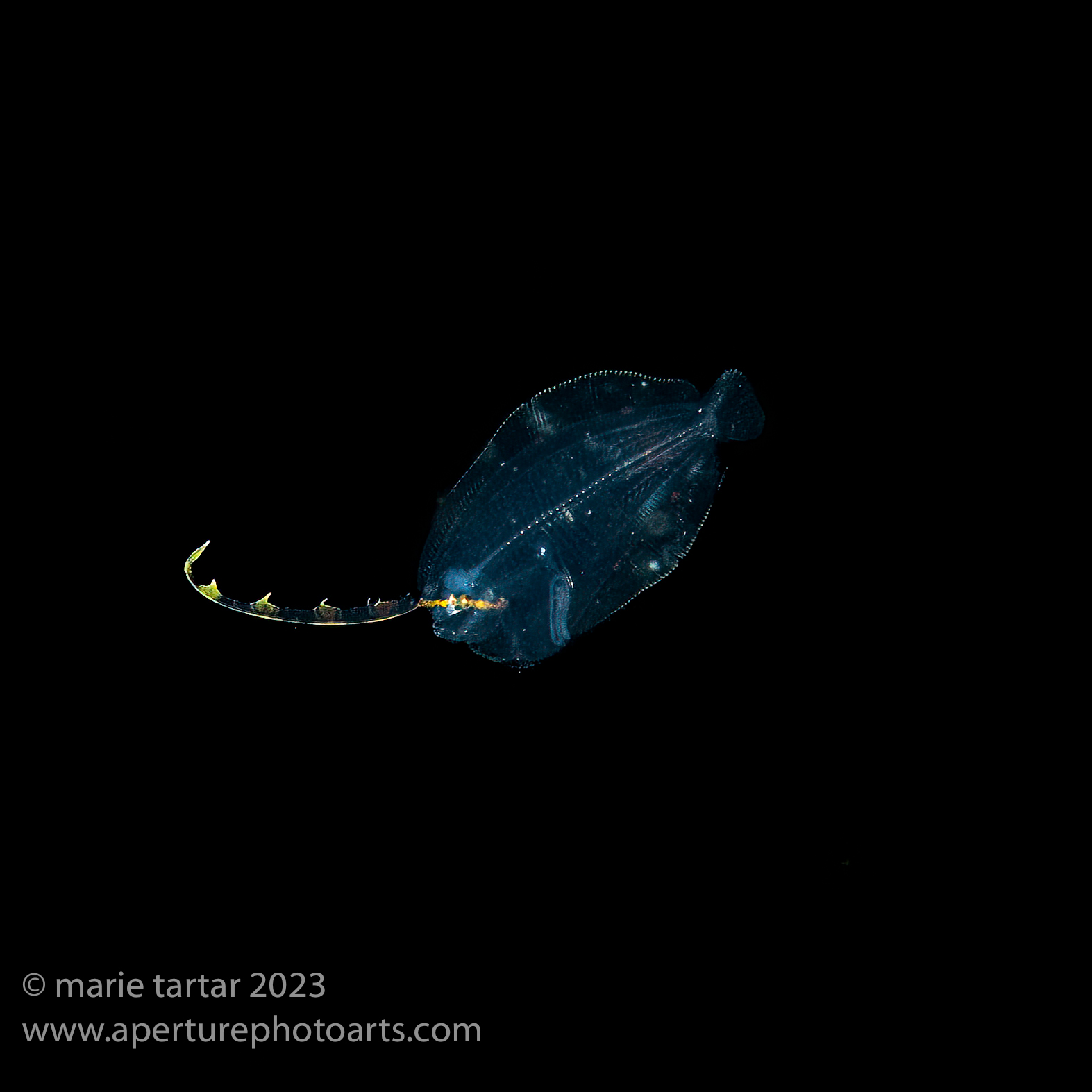
Many fish, such as this tiny flounder, pass through a tiny, larval and translucent stage of pelagic life before settling as adults on the reef.
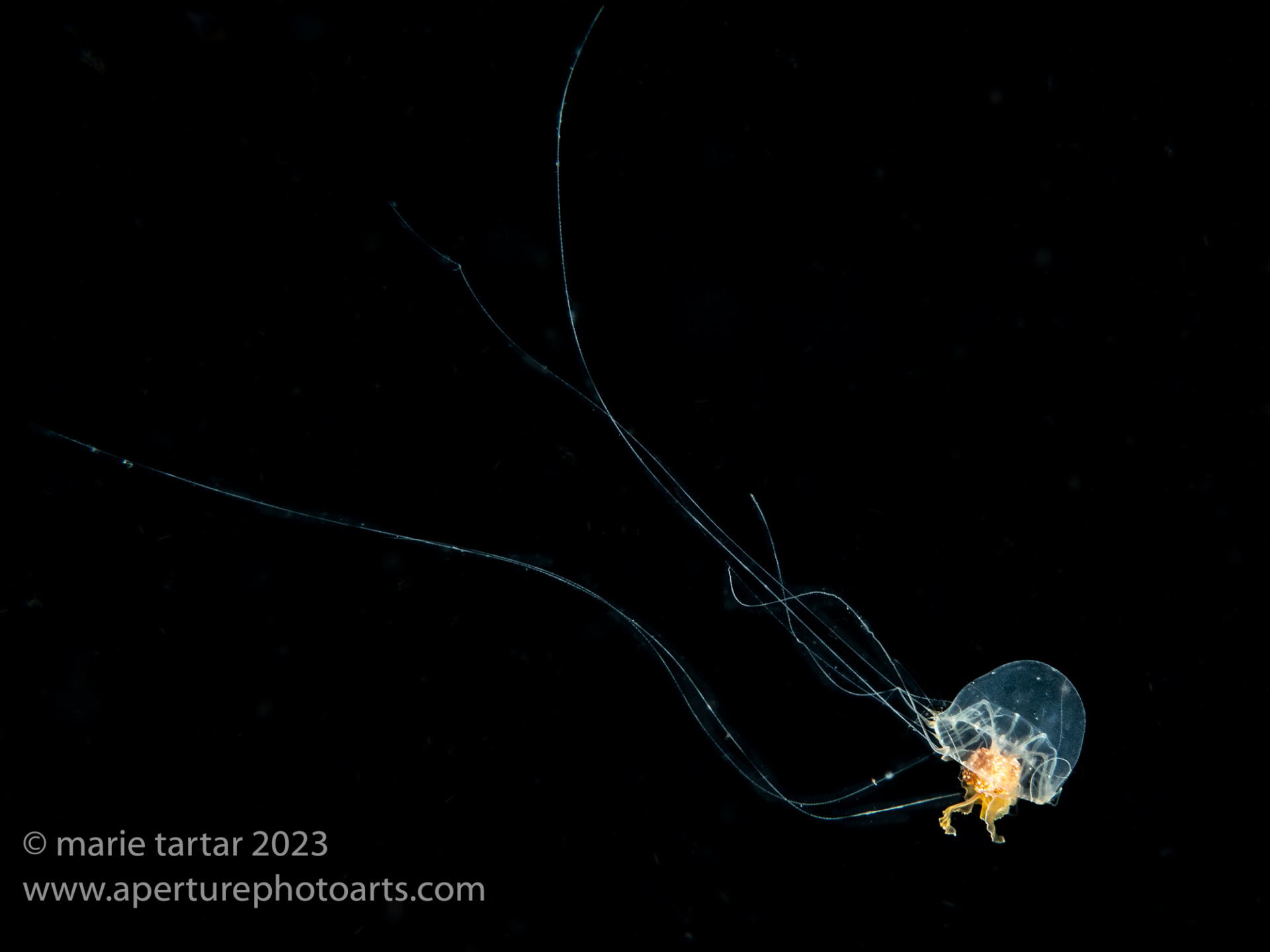
A funny-looking (tiny!) jellyfish in Anilao, Philippines made me think of a parachutist exiting a darkened stage.

Every blackwater dive at Anilao, Philippines, featured abundant comb jellies (ctenophora) like this. The glowing green highlights the cilia “combs”.
64 min 66 feet
61 min 78 feet
Thursday, November 23, 2023
In the afternoon, we dived El Pinoy, where a sea snake coiled, out in the open.
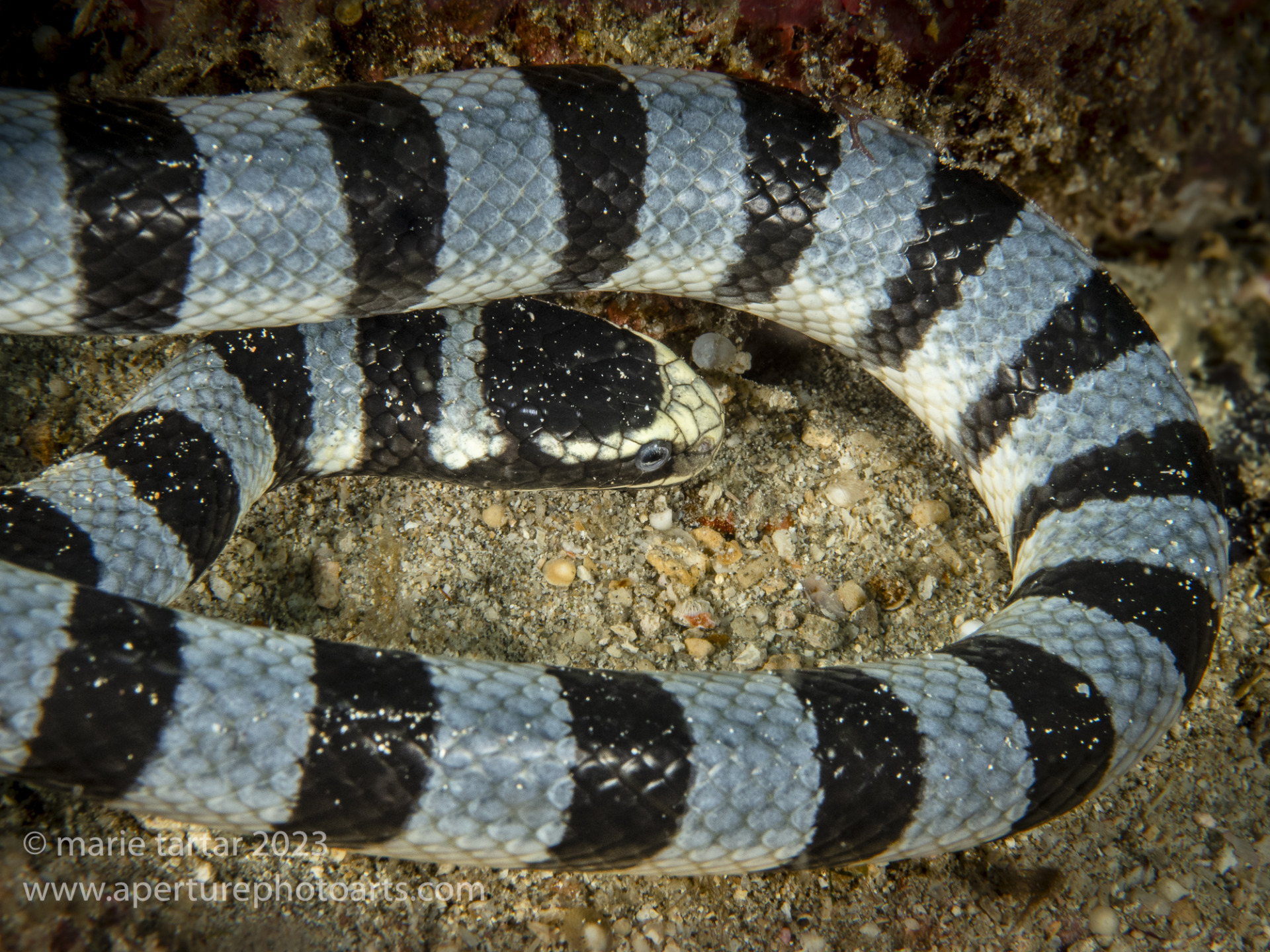
Banded sea krait or snake (Laticauda colubrina), Anilao, Philippines, also known as the yellow-lipped sea krait. It uses a powerful neurotoxin to paralyze its preferred prey (eels) but is not aggressive to people.
Other sightings included an orangutang crab. Jomel helped me with a frustrating chase of a squat lobster deep in the recesses of a barrel sponge, which was definitely not ready for its close-up.
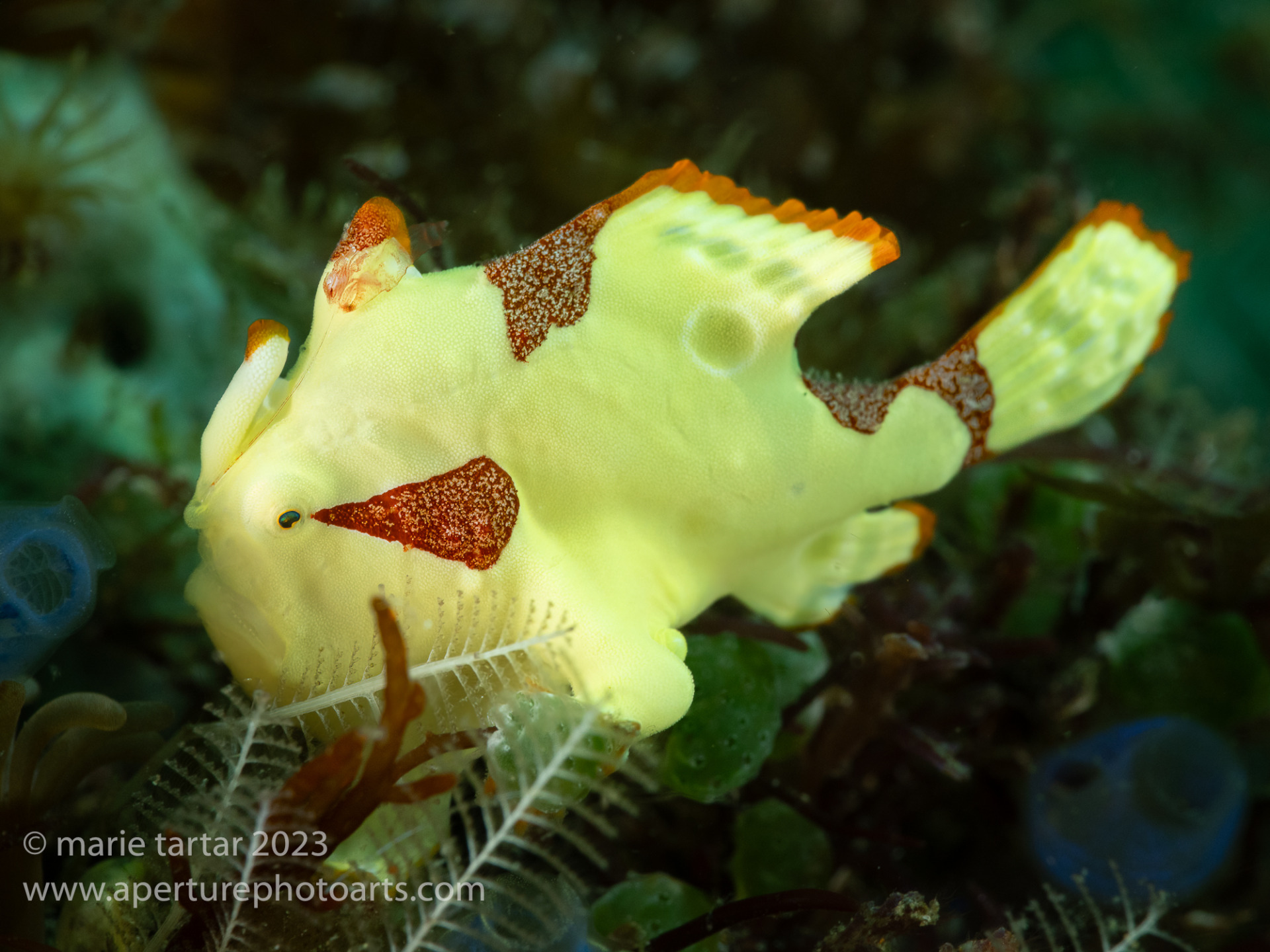
My favorite frogfish (painted) (Antennarius pictus) with matching lure. At Anilao, Philippines, there was no shortage of frogfish, especially tiny examples.
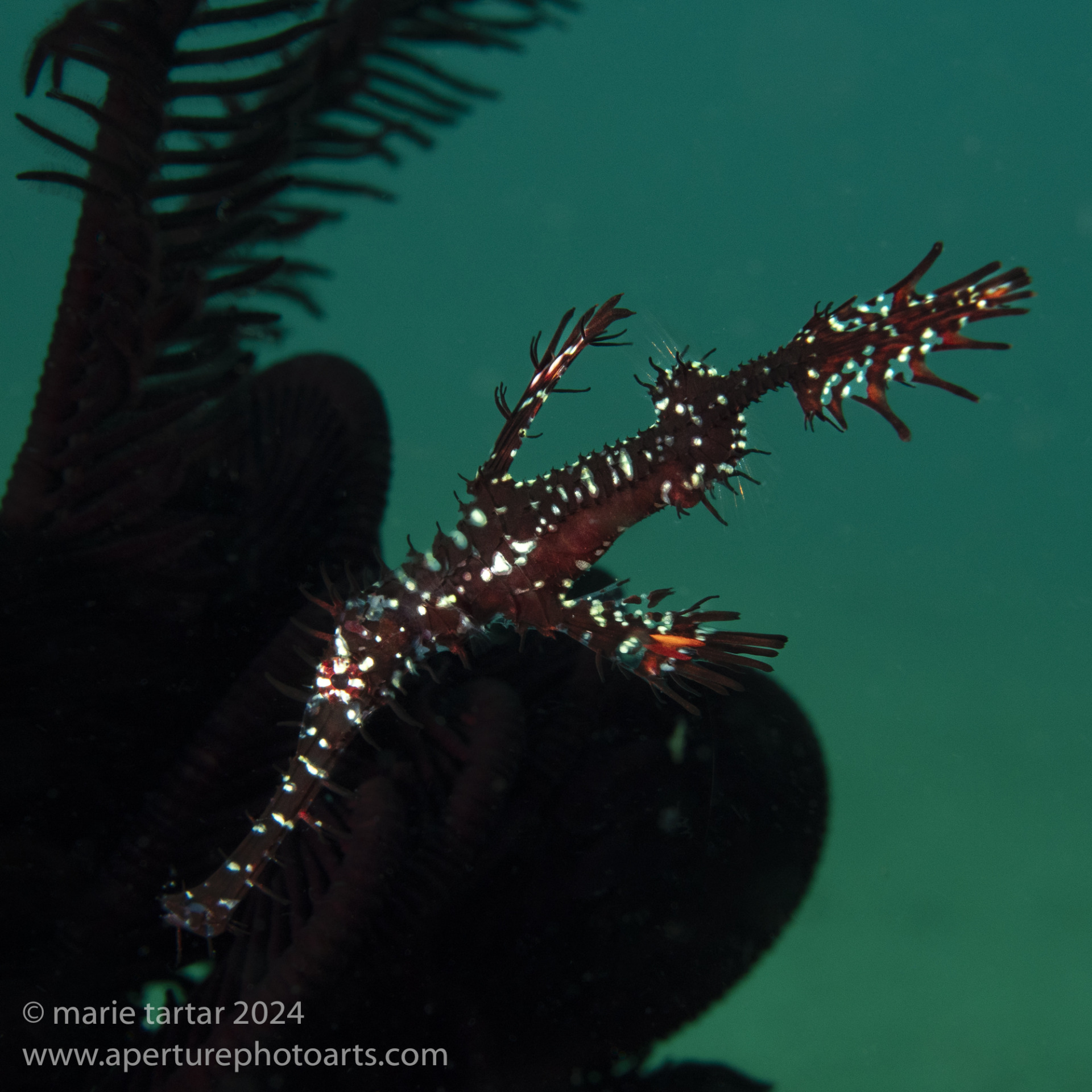
A favorite fish, the Ornate Ghost Pipefish (Solenostomus paradoxus) in one of the harder color combinations to photograph. Anilao, Philippines.
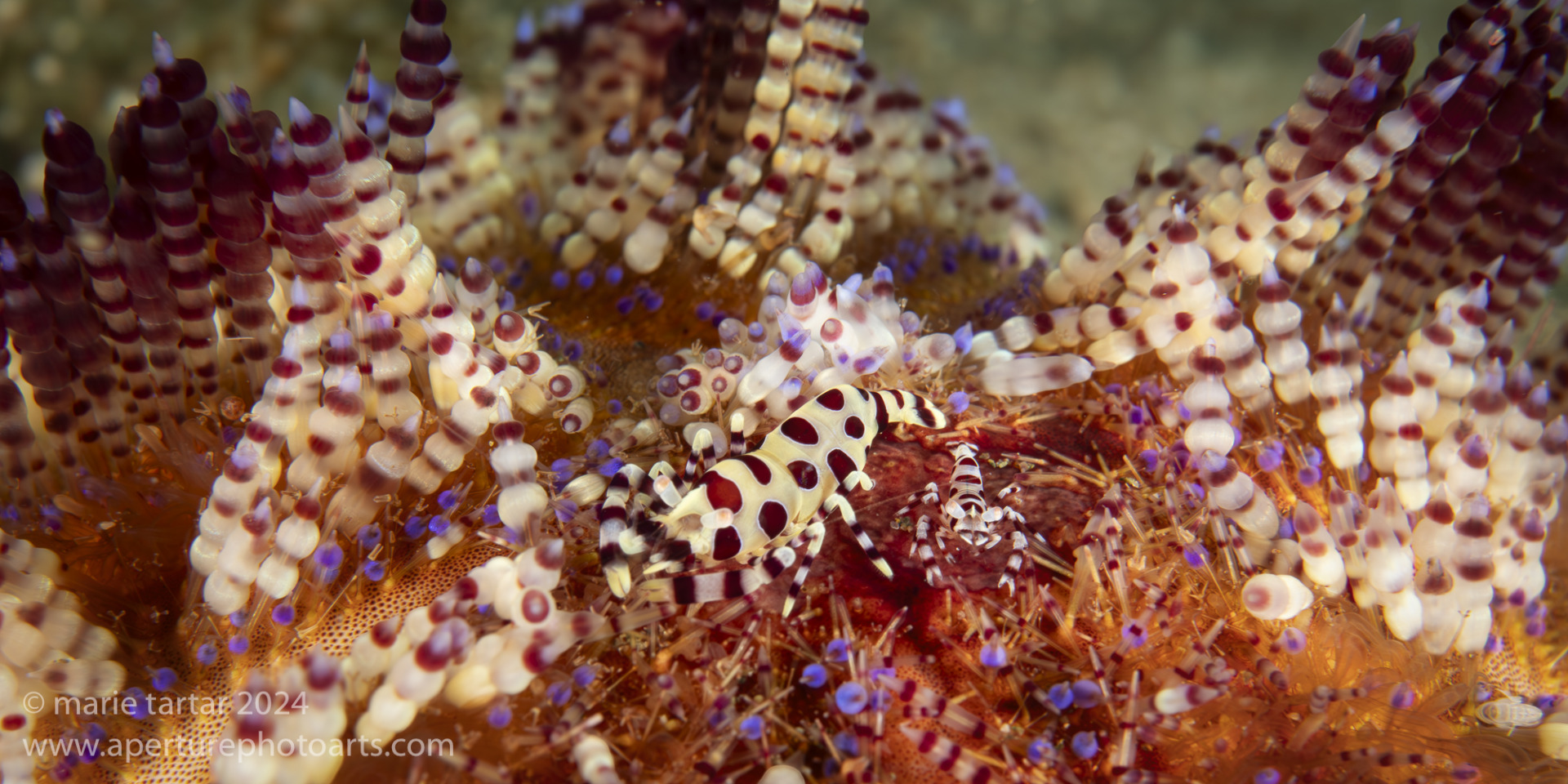
Coleman shrimp pair (Periclimenes colemani) living atop a fire urchin. They clip the spines to groom their preferred patch. The female is the larger of the two.
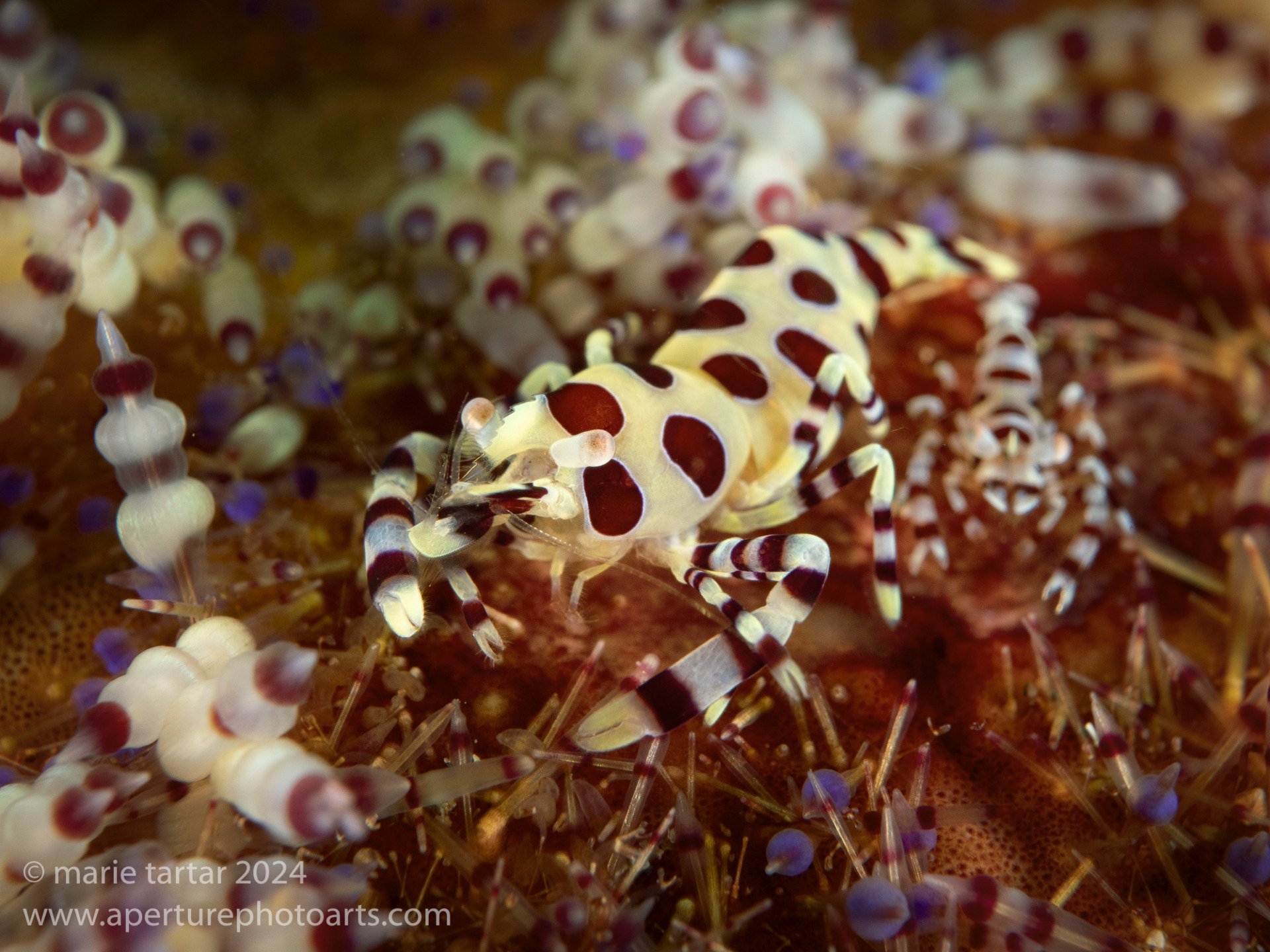
CMC close-up of the female Coleman shrimp, with the smaller male back behind her. Their residence is a fire urchin (Asthenosoma varium). Anilao, Philippines.
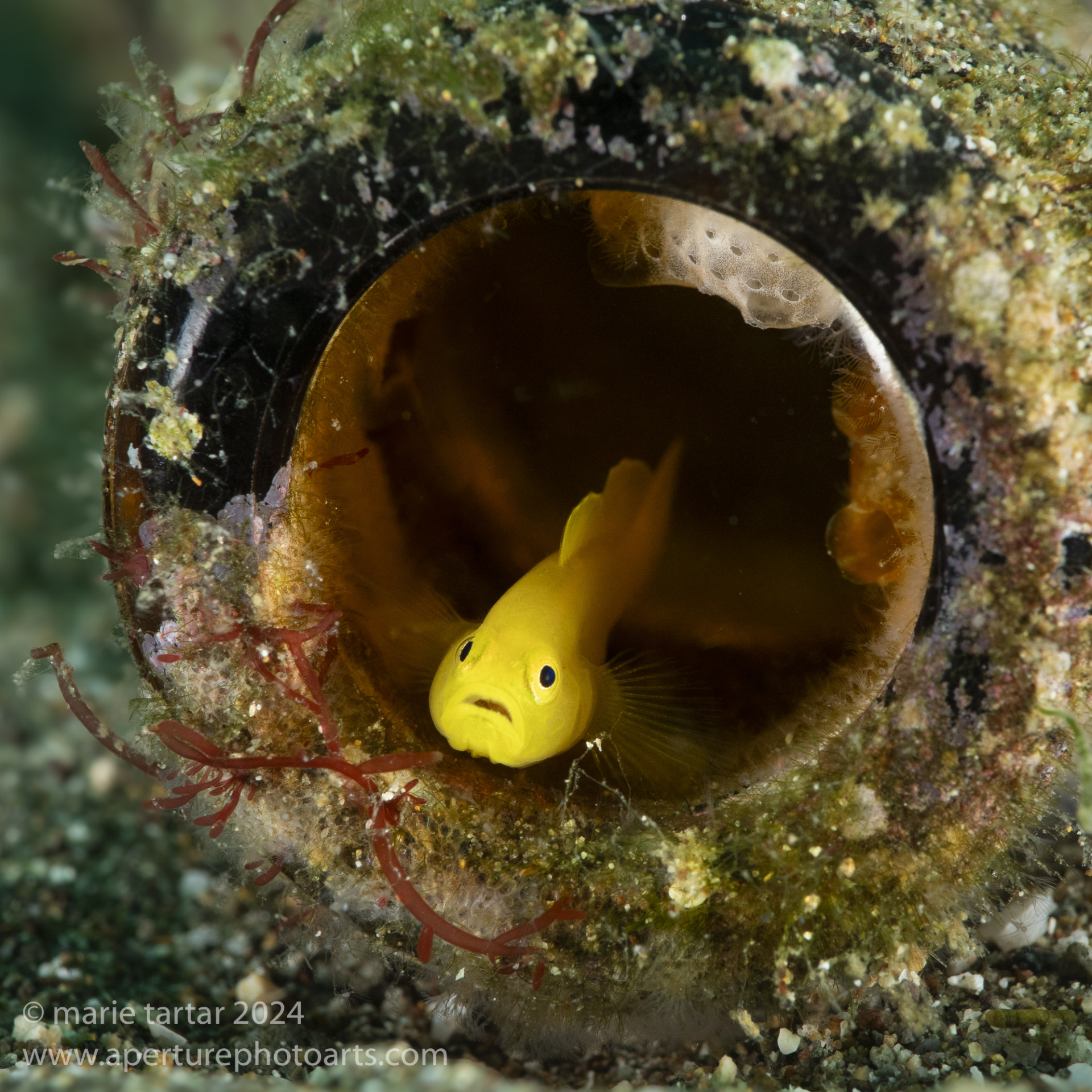
Pygmy yellow goby (Lubricogobius exiguus) peers out of its encrusted bottle home in Anilao, Philippines.
Our boat lucked out again in the evening, finding another wunderpus on the first of our two evening blackwater dives.
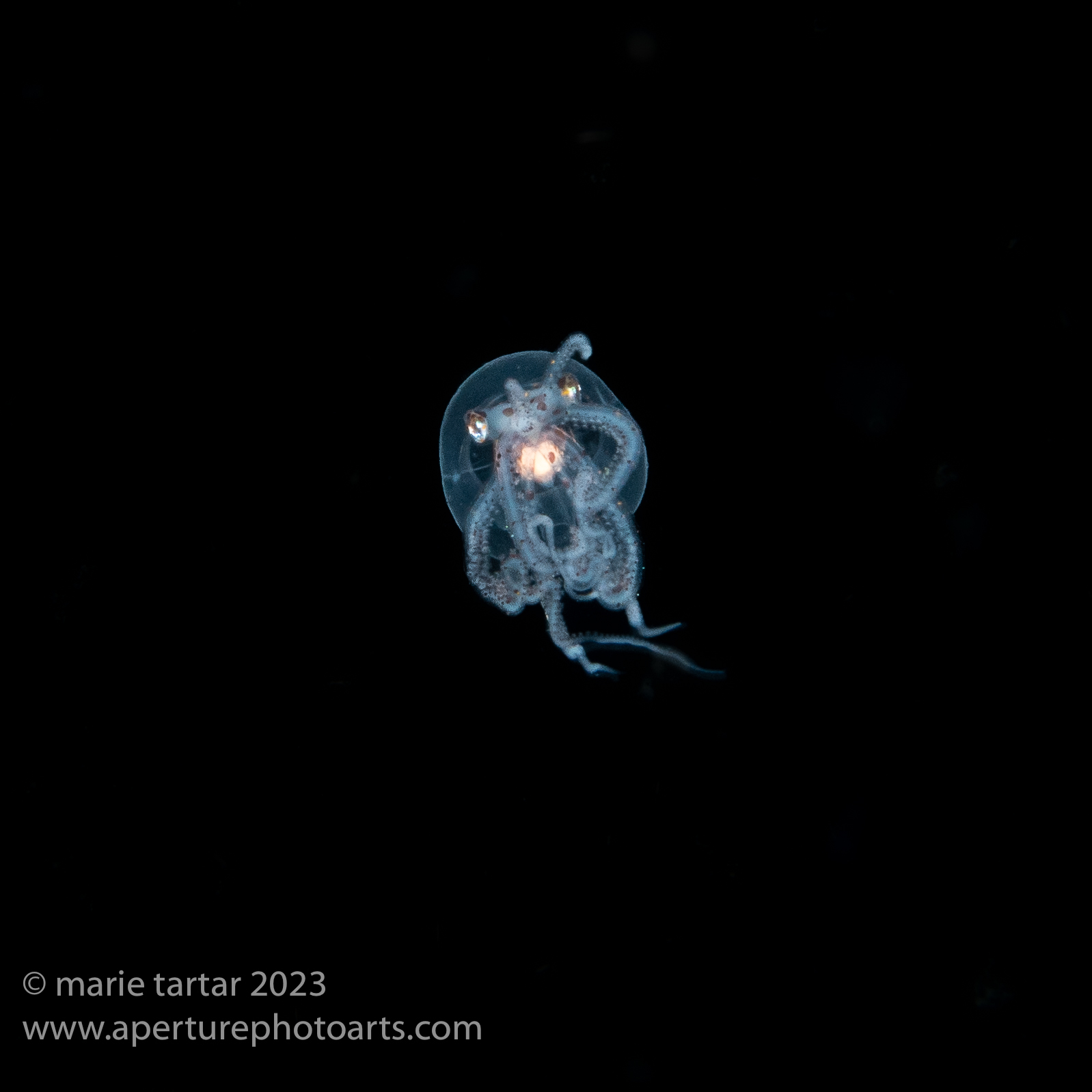
While we were lucky to find another larval wunderpus on our second night of blackwater dining in Anilao, I wasn’t as fortunate in its positioning this time around…still wonderful to see.

At last! A subject that was not microscopic, a Pelagia noctiluca jellyfish. Weirdly, jellyfish are one of the few creatures encountered underwater of which I have historically been afraid (my skin reacts intensely to stings, so I’m always covered head to toe). I should have been afraid of this one, with both the bell and the tentacles packed with stinging cells (nematocysts), but somehow during this trip I found myself more in awe than afraid of these creatures.
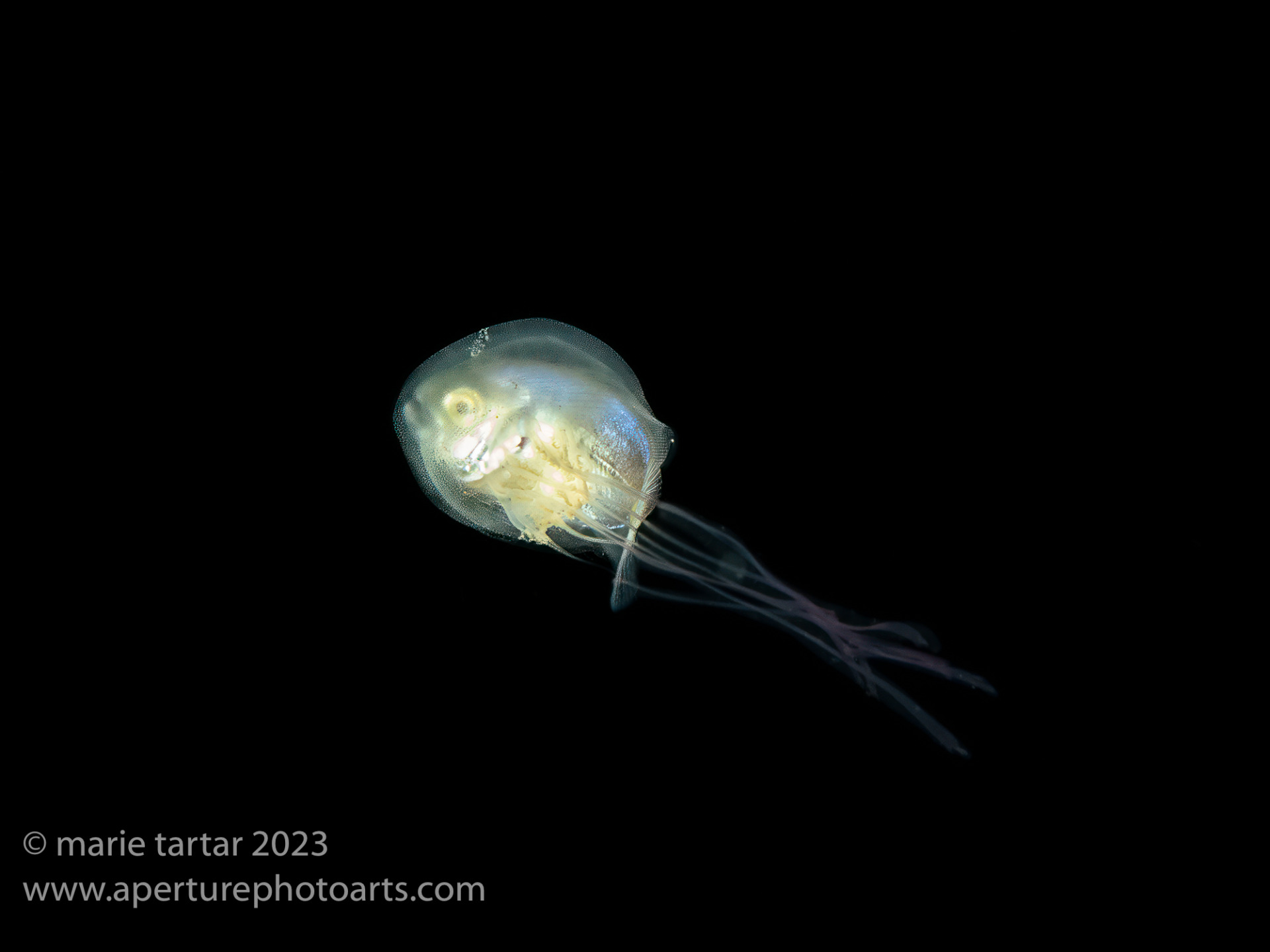
Jack(fish) and jelly(fish) are frequently seen companions. Notice how closely matched in size they are. The presumption is that this is a mutually beneficial relationship, affording the fish some protection from would be predators and enabling the jellyfish to avoid predation with the aid of the faster moving fish.
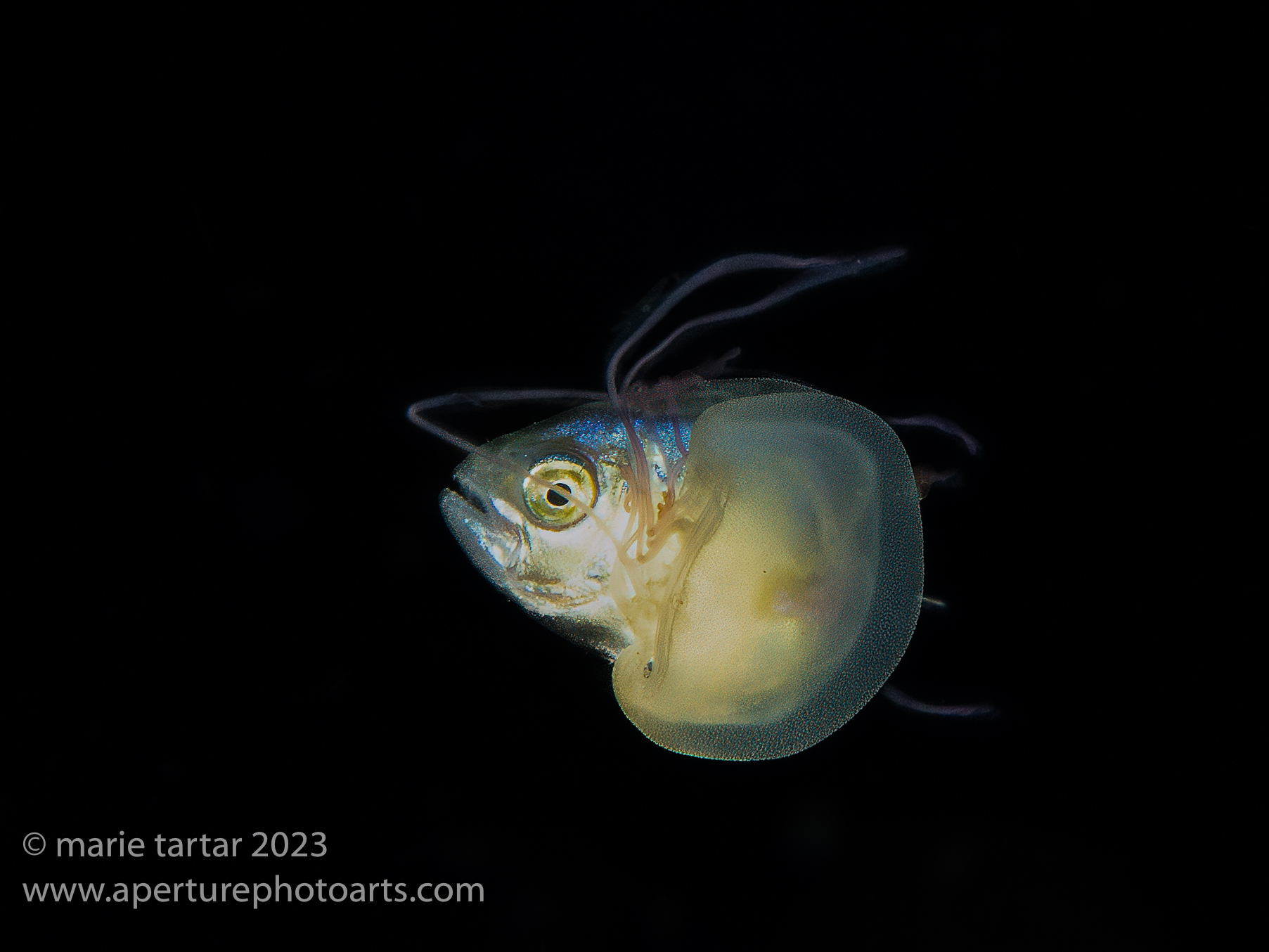
Time to move on? The jackfish seems to be about to cast off its jellyfish companion. Anilao, Philippines.
64 min 71 feet
62 min 81 feet
Friday November 24, 2023
It’s Thanksgiving Day at home, and we found much here for which to be grateful. Although the buffet style meals have many savory choices, there was nary a turkey in sight. We didn’t miss it.
Rob sat out the morning dive we did to Octo Point.
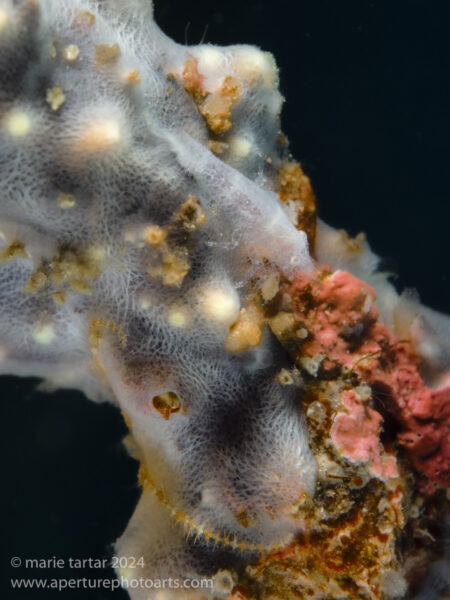
Amazing shrimp matched to habitat, another exceptional example of camouflage in Anilao, Philippines.
67 min 66 feet
In the afternoon, we explored the pleasantly luxuriant coral reef practically in front of the resort, finding a beautiful assortment of nudibranchs. Seeing the same type of anemone in which Jomel had shown me an orangutan crab a few days earlier, I found one on my own (a first). Jomel also showed us spaghetti thin white pipefish masquerading as part of an anemone.
62 min 72 feet

An especially well camouflaged nudibranch in Anilao, hard to tell the back from the front: Phyllodesmium briareum.
That night, we had an extra LONG run (seemed 5X as long as previous nights) out to our blackwater hunting grounds. No amazing sightings rewarded our venture to Balayan Bay. My Backscatter light mounted on top of the housing did not illuminate on the second dive, so I found myself of necessity trying Pash”s technique of holding my narrow beam search light (a rented XTAR) with my left hand and cradling the camera with my left forearm. This didn’t work well for me. I finally remembered my strobes have modeling lights and used them to focus. We found a flatworm undulating through the water towards the end of the evening.
One evening diving with this narrow beam flashlight convinced me it was necessary, so we added two to our bill.
We discovered between night dives, when I went to drop some weight, swapping 3 lb weights for 2, that Steve’s and my weight pockets had been swapped, probably all day. From 18 pounds to sink this new 5 mm Henderson Aqua-lock Quick Dry suit at the beginning of the trip, I ultimately whittled down to 12 pounds by the end of the trip (even with a 5 mm hooded vest added).
66 min 70 feet
59 min 78 feet
Saturday, November 25, 2023
Our whole boat sat out the morning; Steve and I slept in until 8 am!
Alex’ after lunch presentation focused on macro techniques, including using a snoot. Snoots basically narrow a strobe’s beam, producing a spotlight effect and can be a good macro muck option, especially in a setting where the sand substrate isn’t the prettiest. Alex advised positioning the snoot at 12 o’clock, with the arm clamped down, except near the snoot. He uses back button focus and encouraged us to set up on an inanimate subject with a low ISO, fast shutter speed and closed aperture.
He also clarified when one would use front vs. rear curtain sync; that is, while the shutter is open, does the flash go off at the beginning or the end of this period? Most cameras default to front curtain, which Alex uses for blur shots to create a sense of motion. In this scenario, after the flash goes off, the camera is panned for accelerated motion. When the camera is held still, rear curtain sync is preferable.
At that afternoon’s image review, I submitted an image I couldn’t make heads or tails of. He identified it as a small circumglobal crustacean, a hyperiid amphipod, which takes over a salp, eating out the inside and killing it, in order to nurture its babies within the protective remaining tube. The mother Phronima sedentaria uses the salp as a nursery, laying her eggs inside and then paddles it around while caring for her young.

A scary Anilao creature, seemingly right out of Alien, a Hyperiid Amphipod (Phronima sedenteria). The crustacean mother with the four red eyes takes over and cleans out a salp. That belt of tiny white specks are a bevy of babies.
Alex also demonstrated the use of the rubber stamp tool in Photoshop to clean edges of slightly soft eyes, giving the impression of sharpness.
We did make it out in the afternoon, to Saimsim. I forgot my dive computers back on the chargers in the camera room and ended up using Steve’s back up computer.
72 min 78 feet
I went in with my camera system set up with the Backscatter snoot and one Inon strobe. This was how Rob and Pash usually dived. I found it somewhat difficult to manage but then my snoot experience is minimal and dates back to before the pandemic. Our subjects included a tiny yellow seahorse and a peach frogfish. I found a peacock mantis shrimp.
It was raining and cool, enough to dig out my fleece jacket and cap. Although October is generally considered the last month of the rainy season, we had abundant rain. It usually came overnight and didn’t really interfere with our program. I had to go directly from the afternoon dive, dripping wet, to my massage.
We did 2 blackwater dives again:
62 min 71 feet
62 min 89 feet
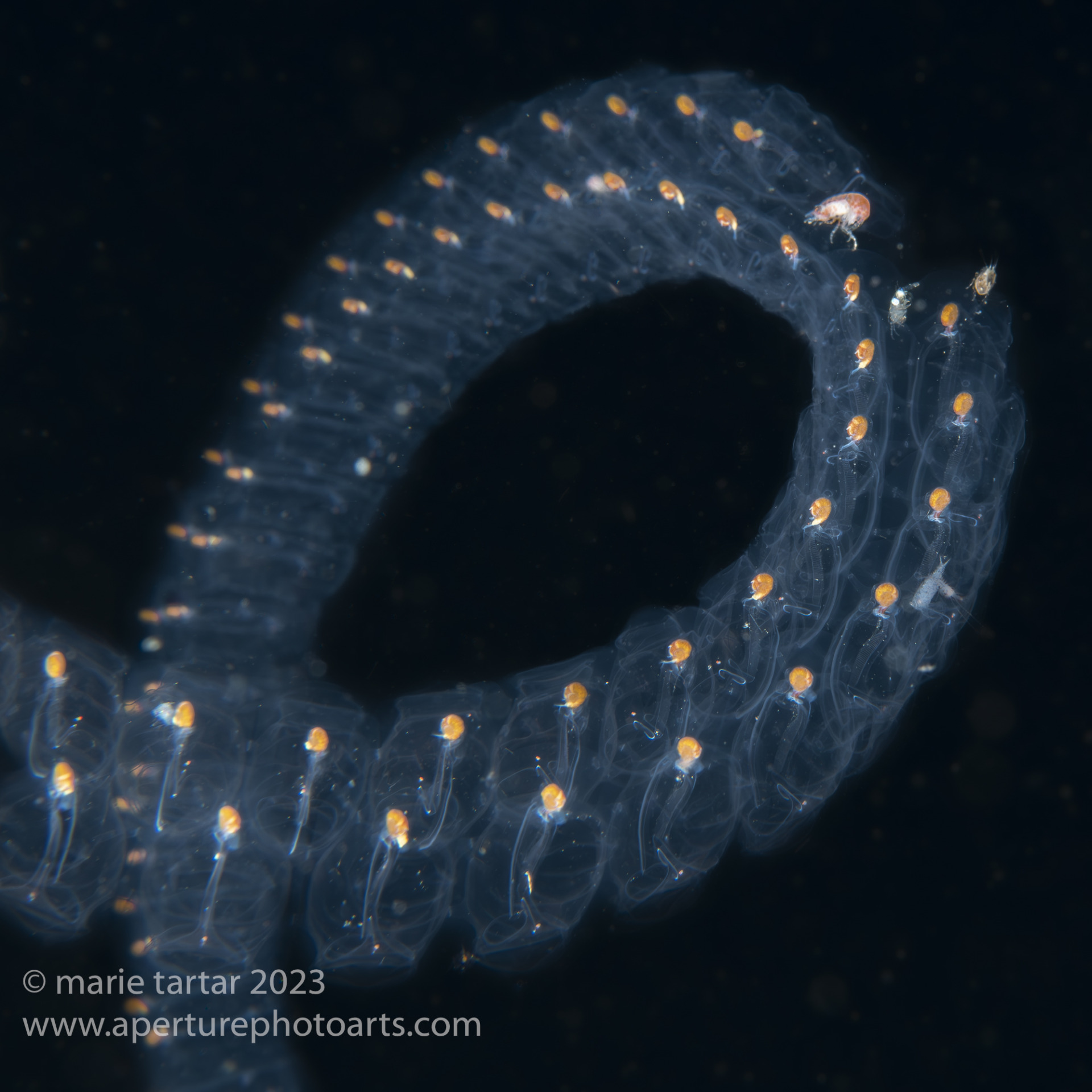
A tiny crustacean (an amphipod) rides on a loop of a salp chain swirling around on a blackwater night dive in Anilao, Philippines.
A word about keeping up with the downline: Once we became comfortable, it was easier and easier to wander further and further away from the downline. That may seem surprising, but being close to the line, with its intense lights and jerking motion up and down, was rather noxious. Conversely, away from the line and especially if no larger animals were in the vicinity, it was easy to find one’s attention occupied by the square meter of water immediately in front, illuminated by the light mounted on top of the camera. In this microcosm, tiny specks zipped around. It was like diving on that science class slide with a drop of sea water, which under the microscope was alive with wriggly and darting plankton. While in my head like this, it was easy to find oneself in COMPLETE darkness, which is as unnerving as it sounds. To find my way back to the vicinity of the line, I’d have to drop my lights down and spin around in a circle, searching for a subtly brighter slice of water than the otherwise ALMOST complete darkness. Some nights, we would find ourselves having to really swim for it just to keep up with the free-floating pumpkin. It sounds scary, but it isn’t unusual on a blackwater dive for the downline and the divers to end an hour’s dive MILES from where the dive started. There is no sensation of this underwater, other than the occasional dive where the pumpkin and line were really moving and we’d have to continually swim to keep the line in sight. Of course, the success and safety of such a program hinge on alert and experienced boatmen, who follow the glowing orb on the surface.

Blackwater, Anilao, Philippines: The “pumpkin”, a lighted glowing orange buoy, is our lifeline. Our boatmen follow the orb and the lighted line suspended from it, and the divers keep the line in visual range. Both the divers, pumpkin and boatmen drift with the current for the hour-long dive.
Anilao is so ridiculously productive that I’m going to break up this blog into two sections, week 1 and 2, lest the processing drag on forever and I never actually finish these missives.
-Marie


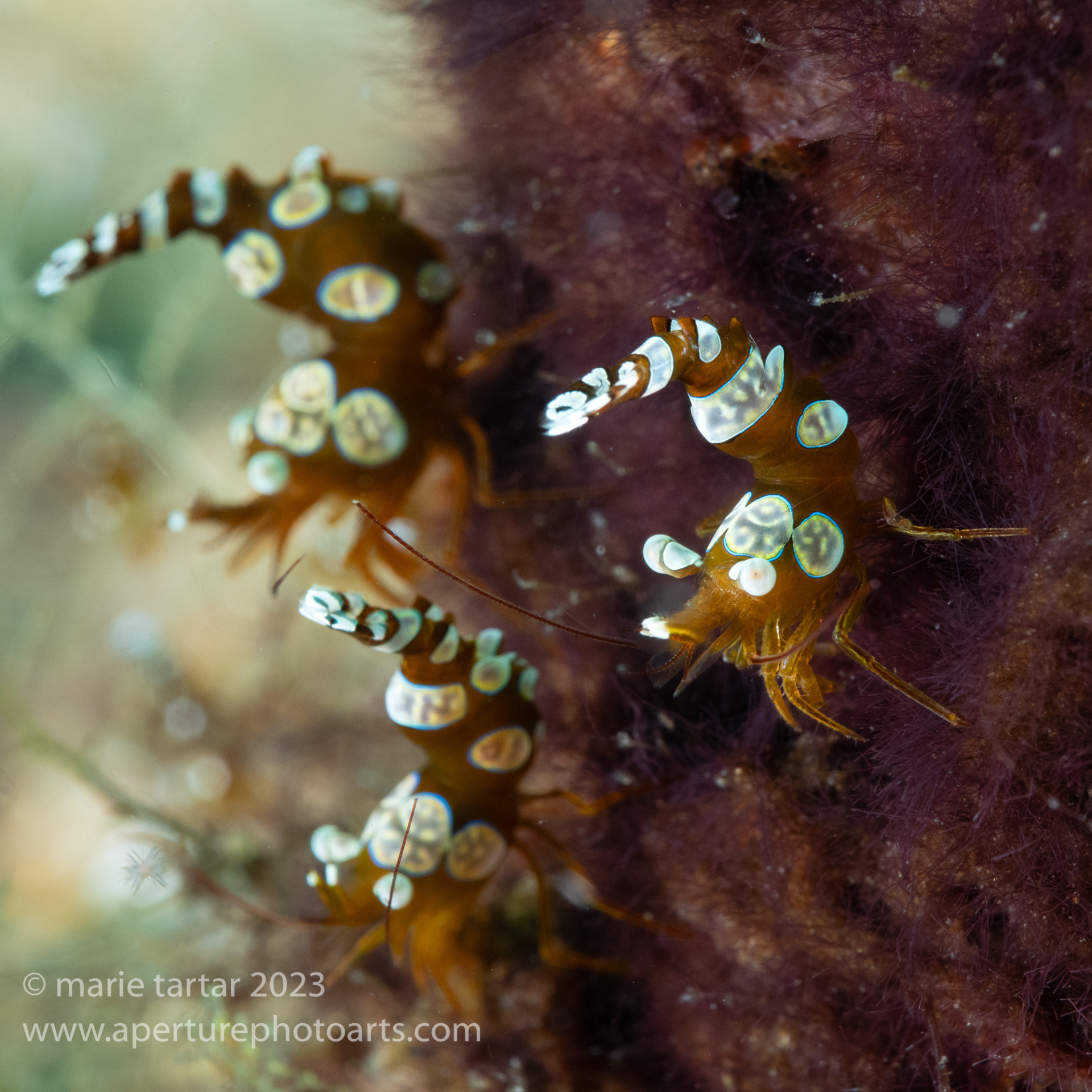
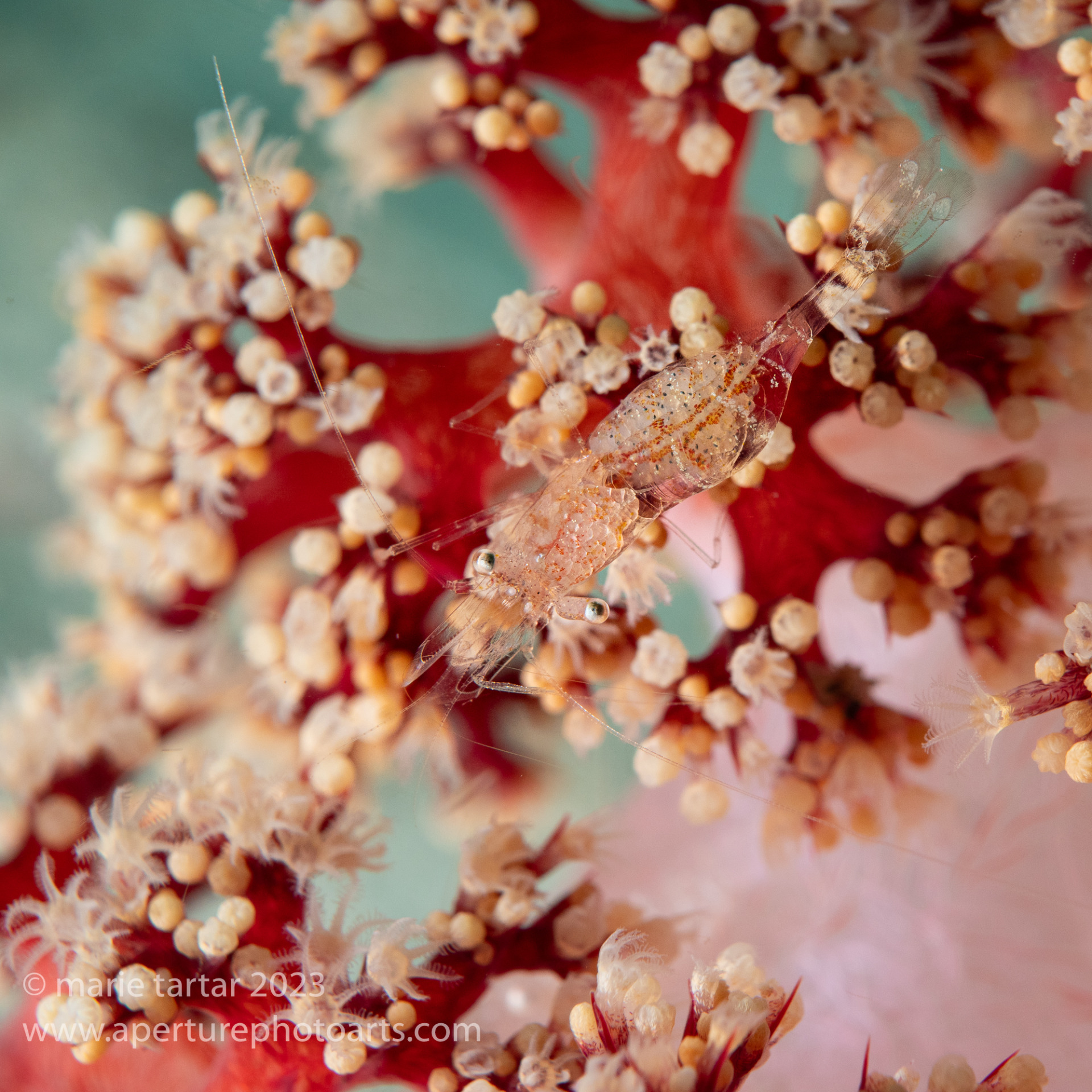
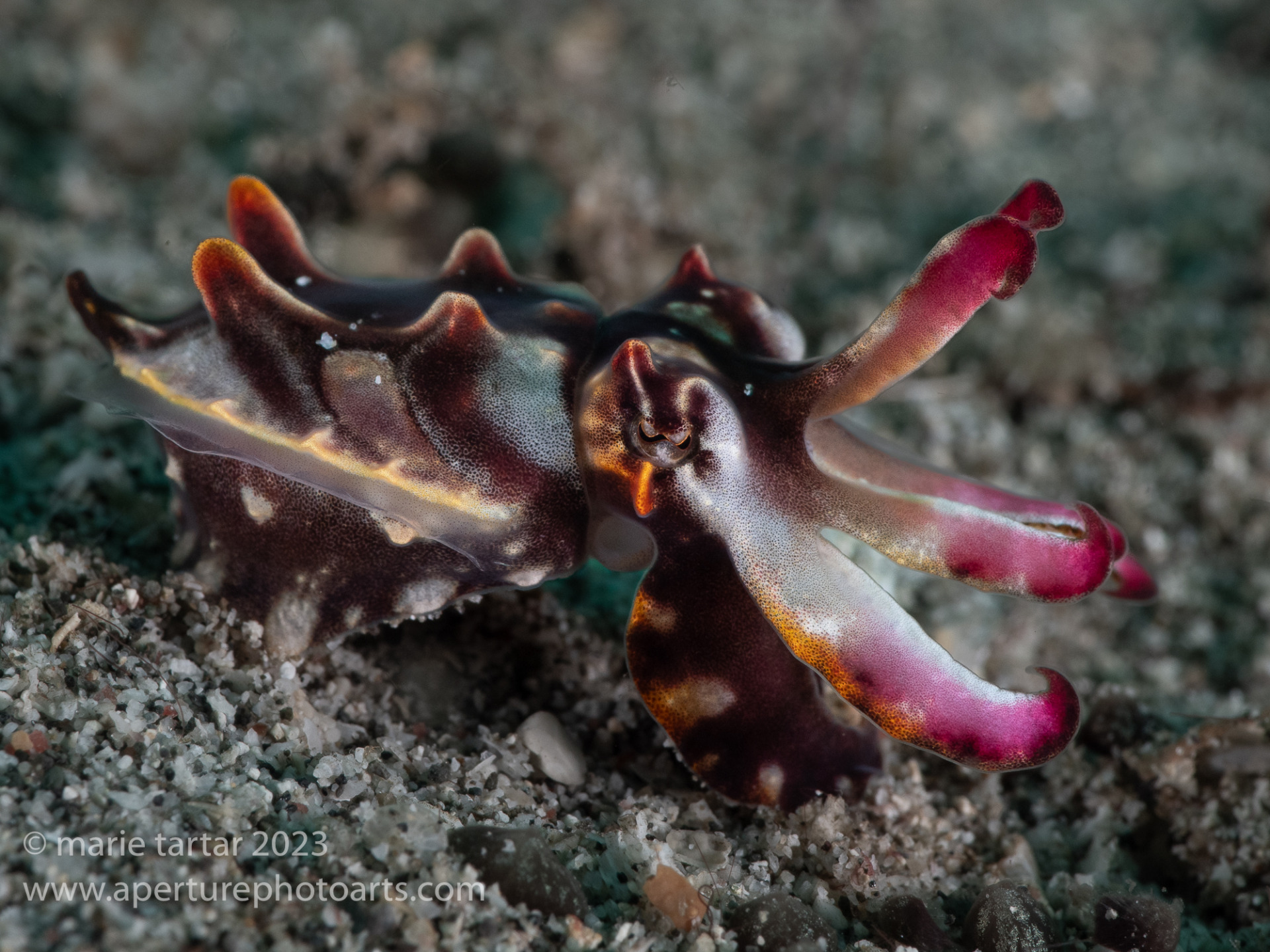

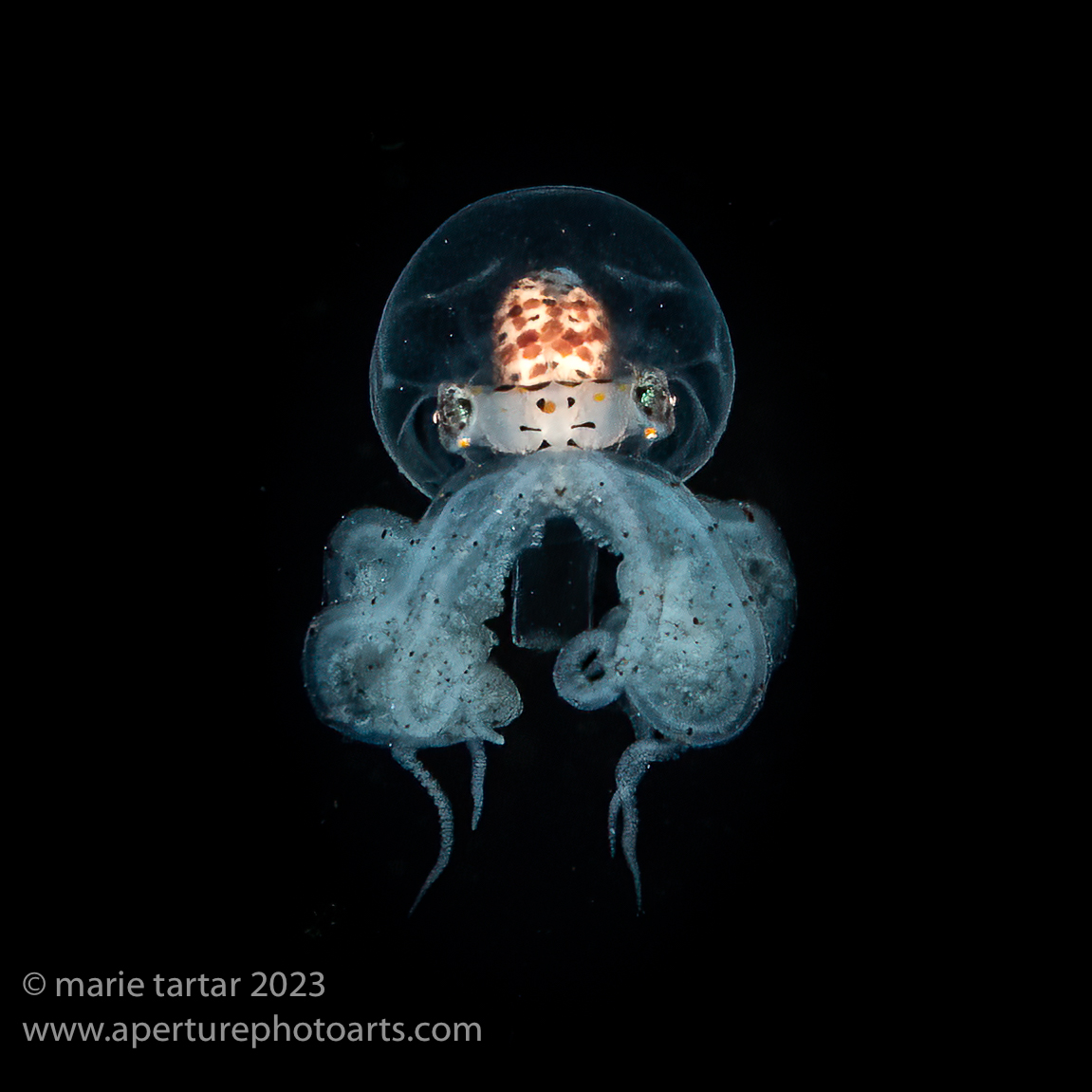
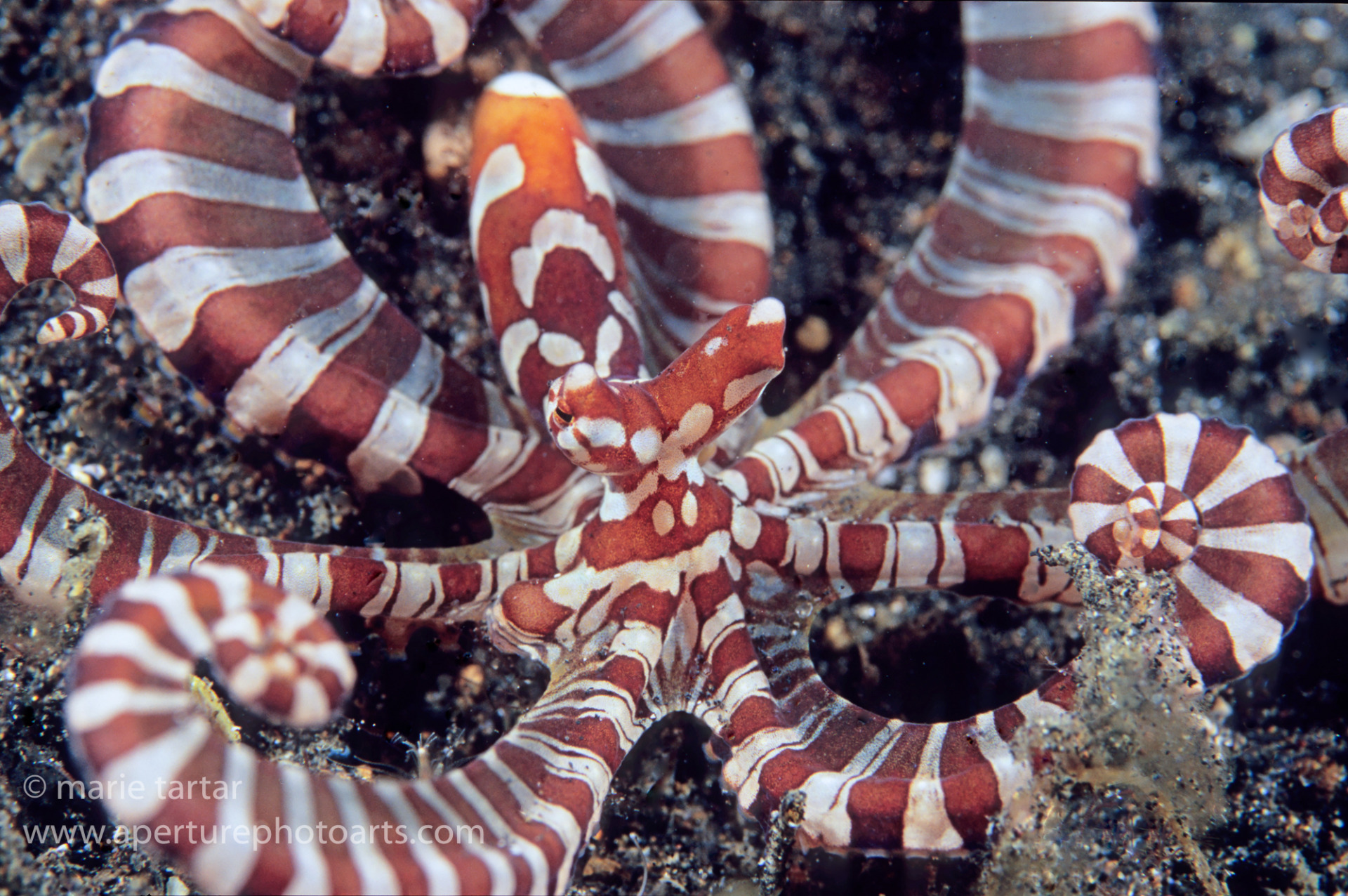
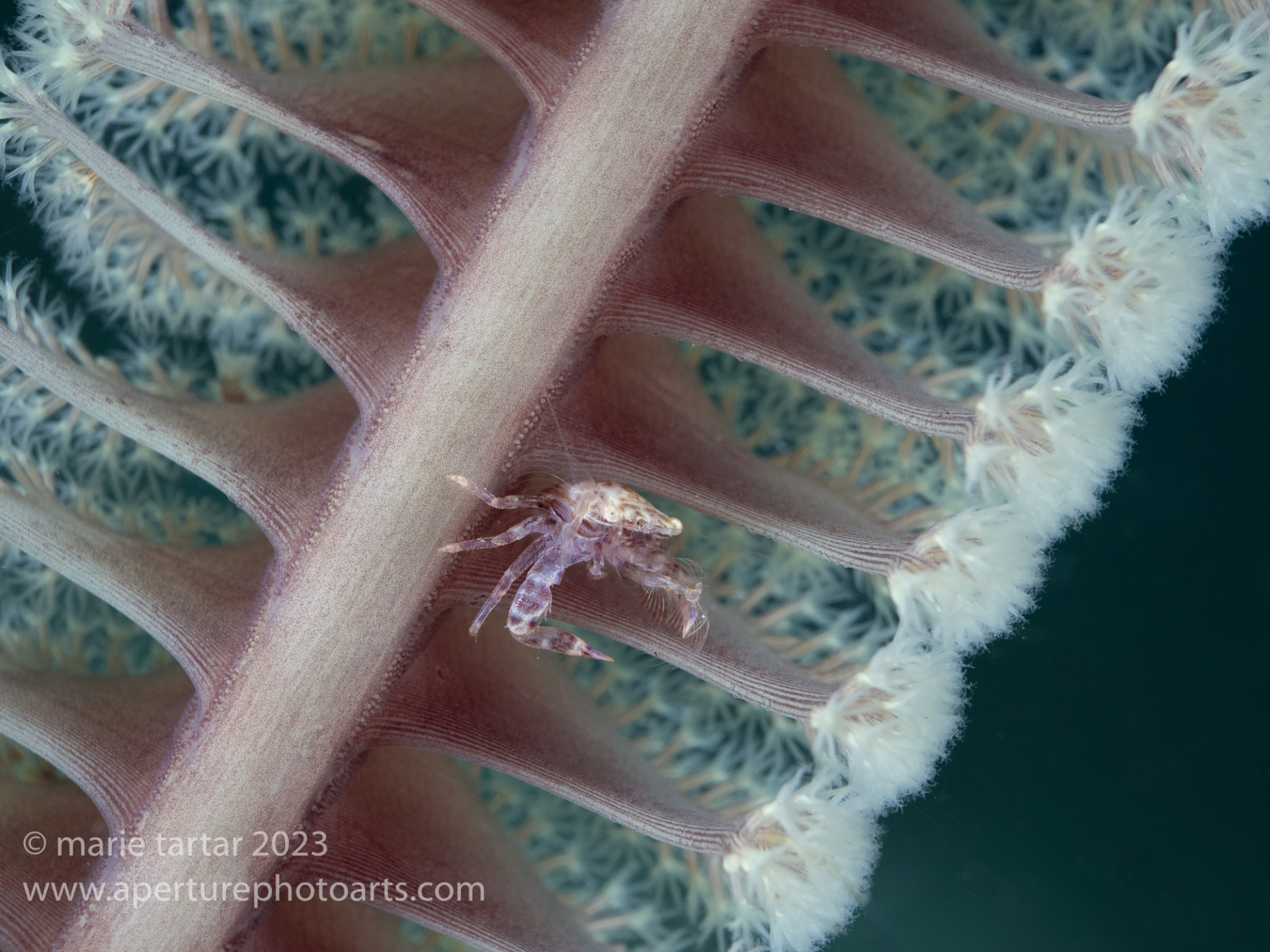

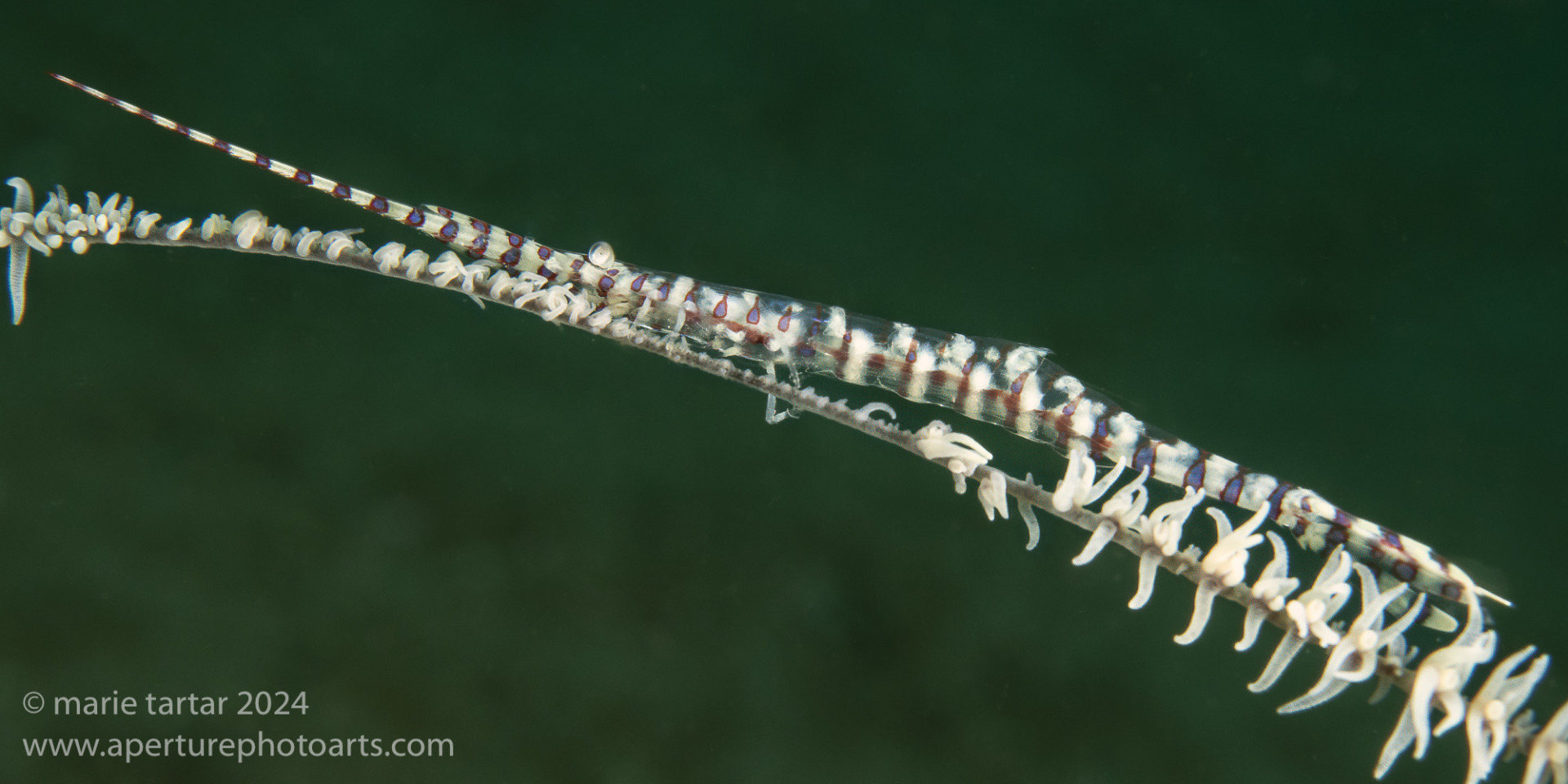

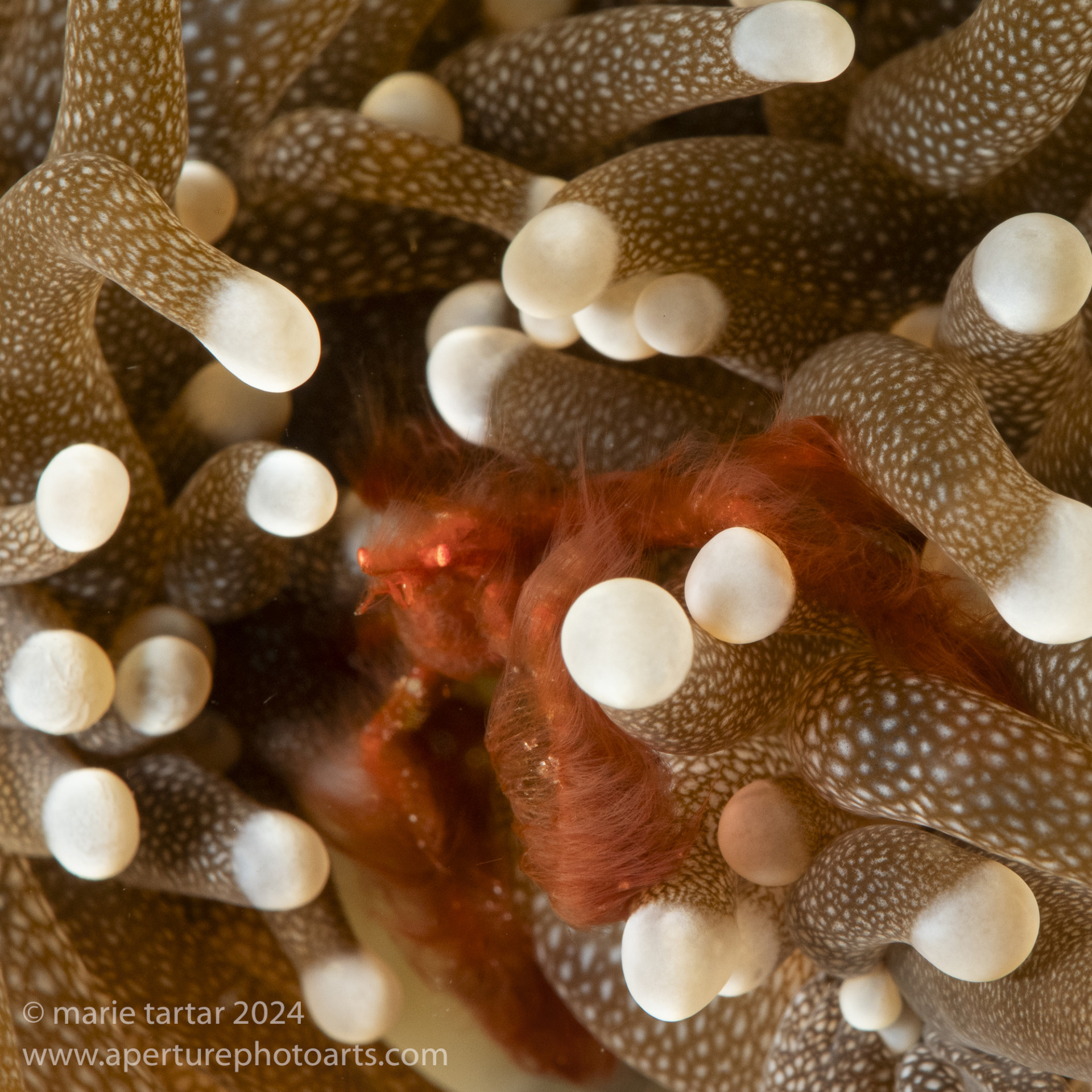
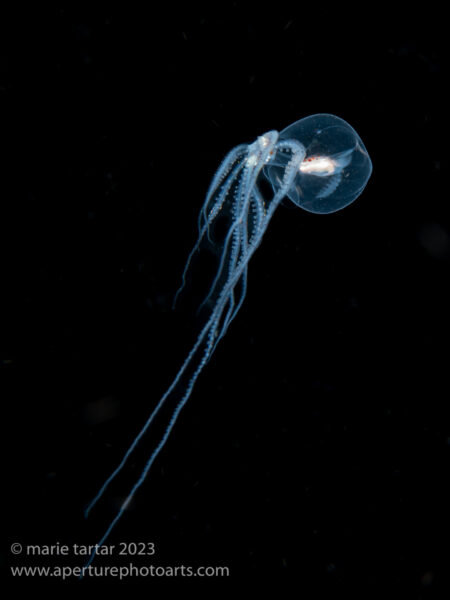
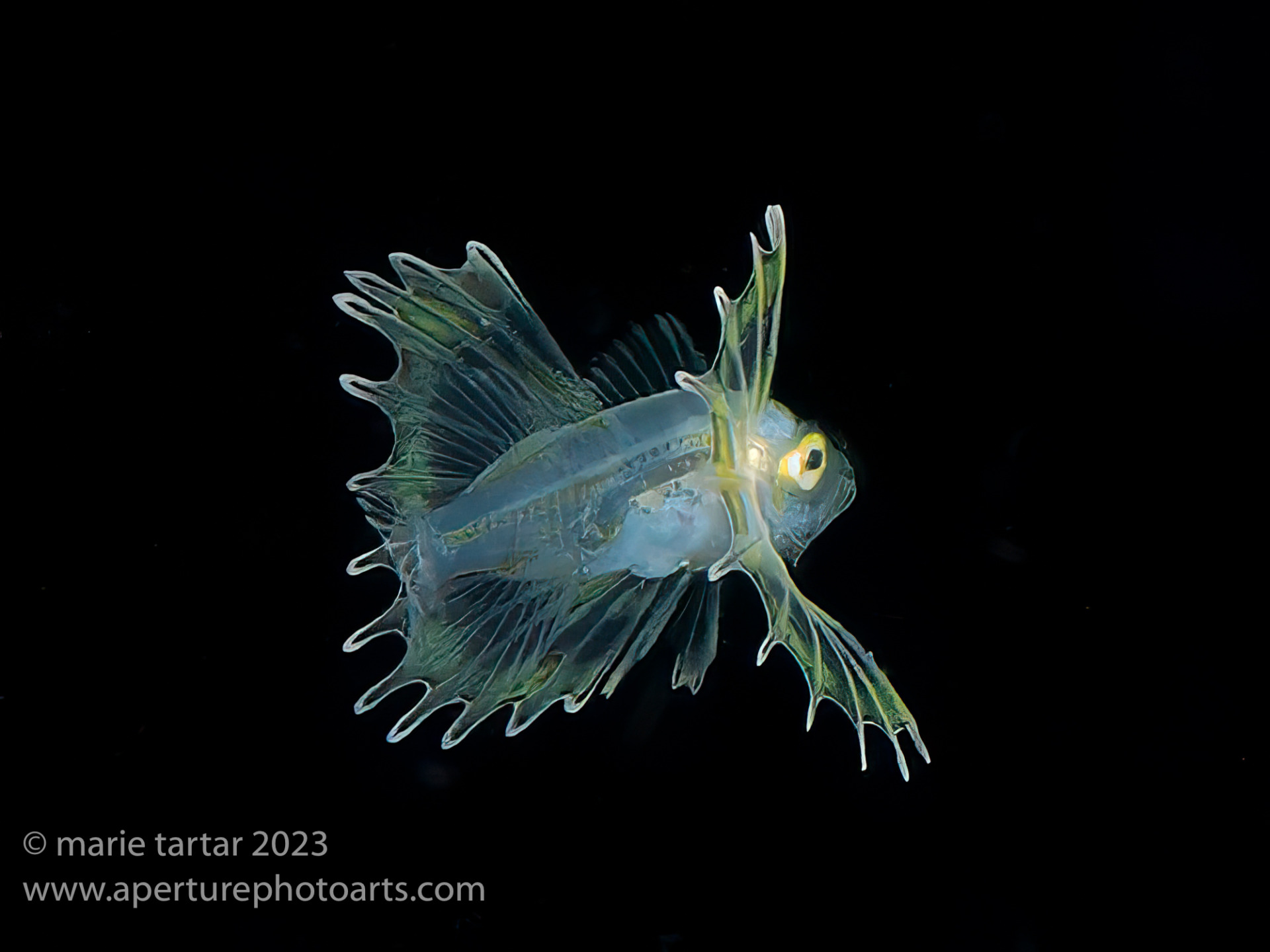

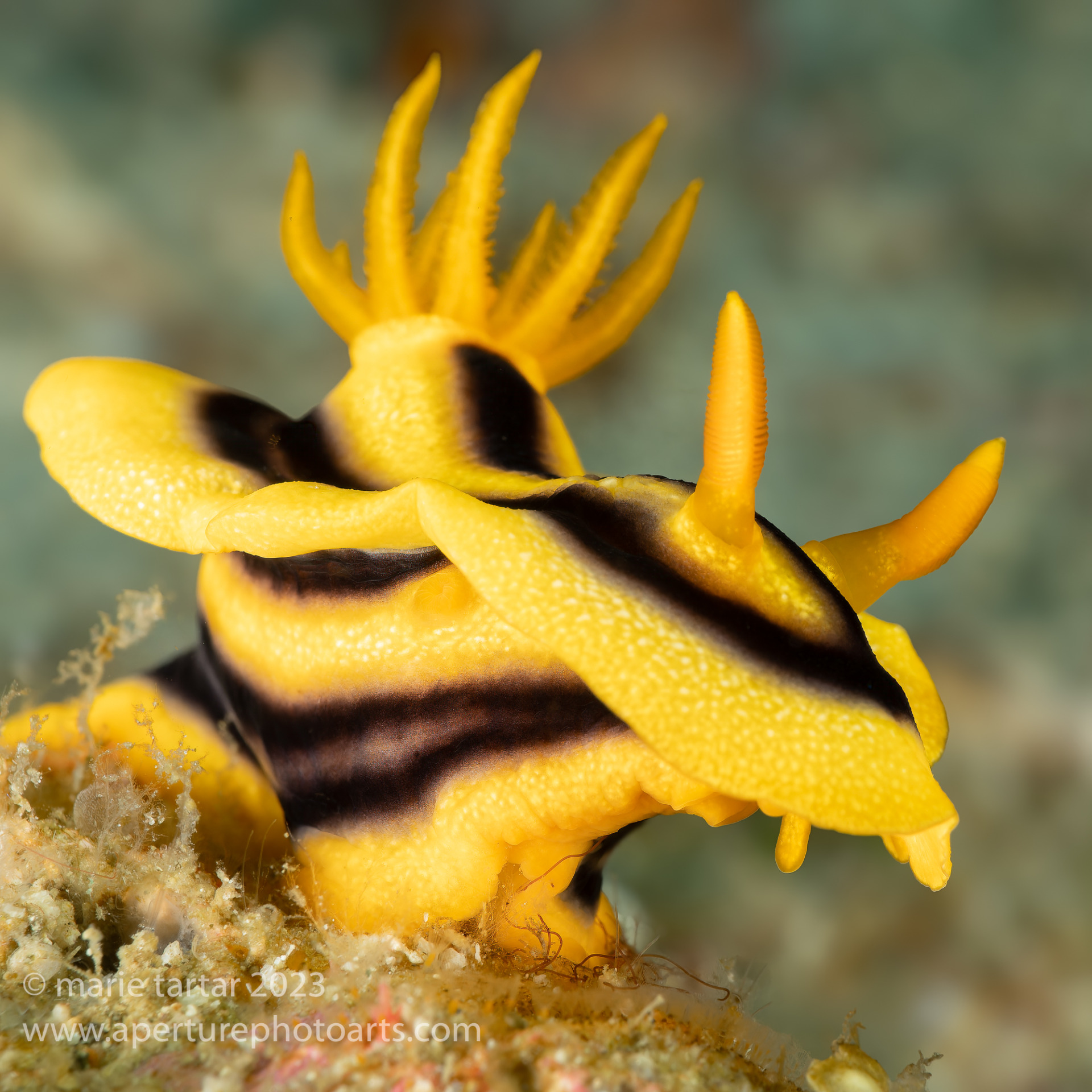

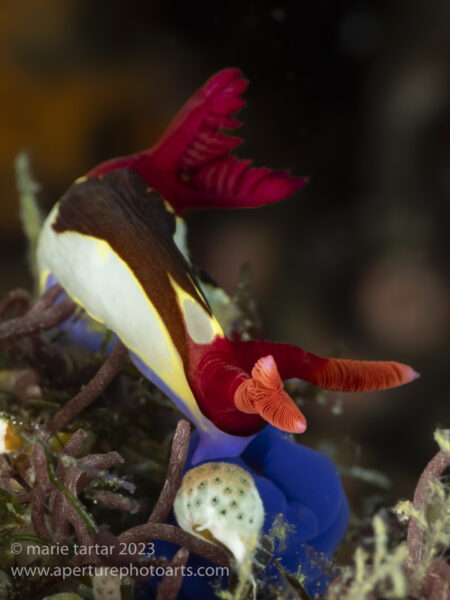

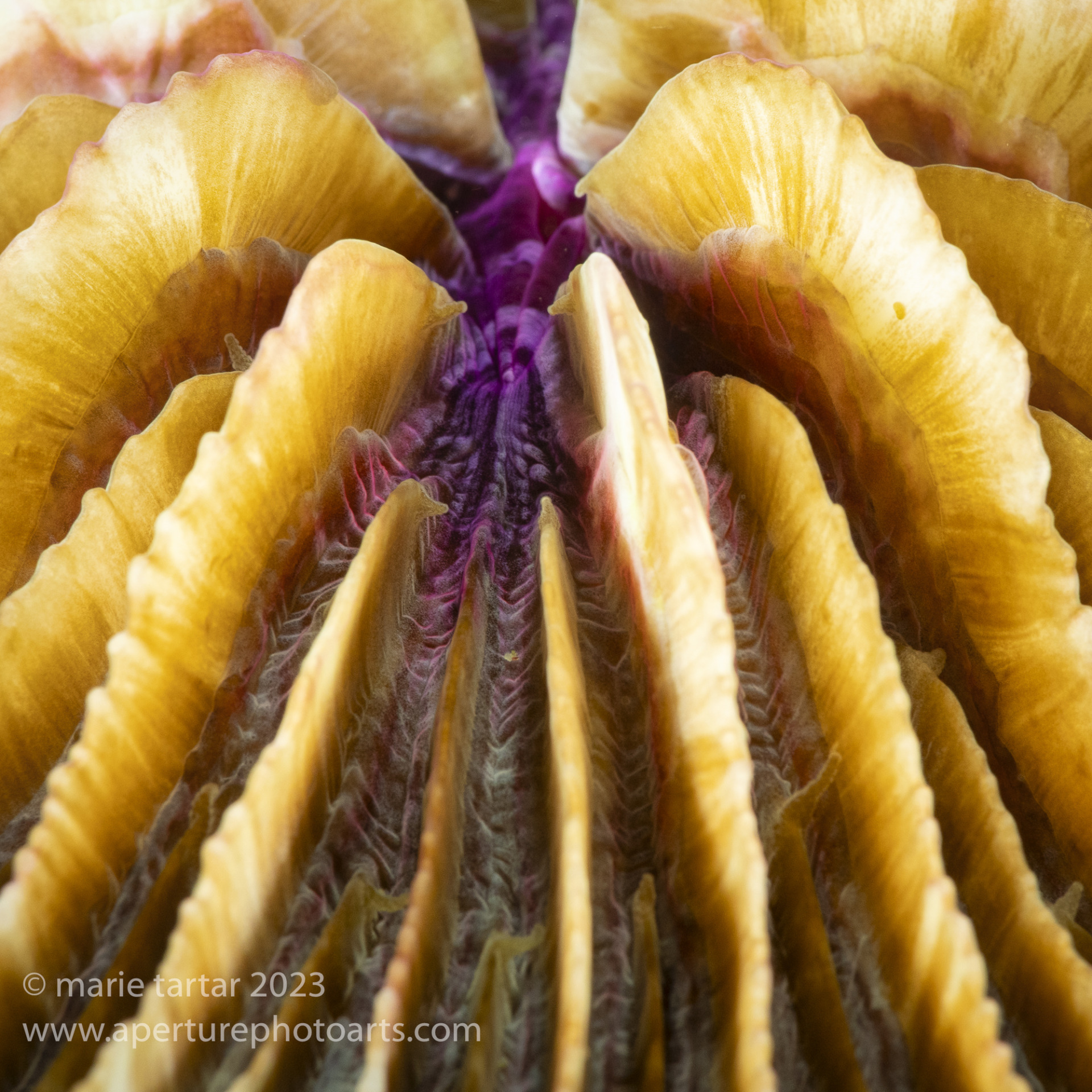
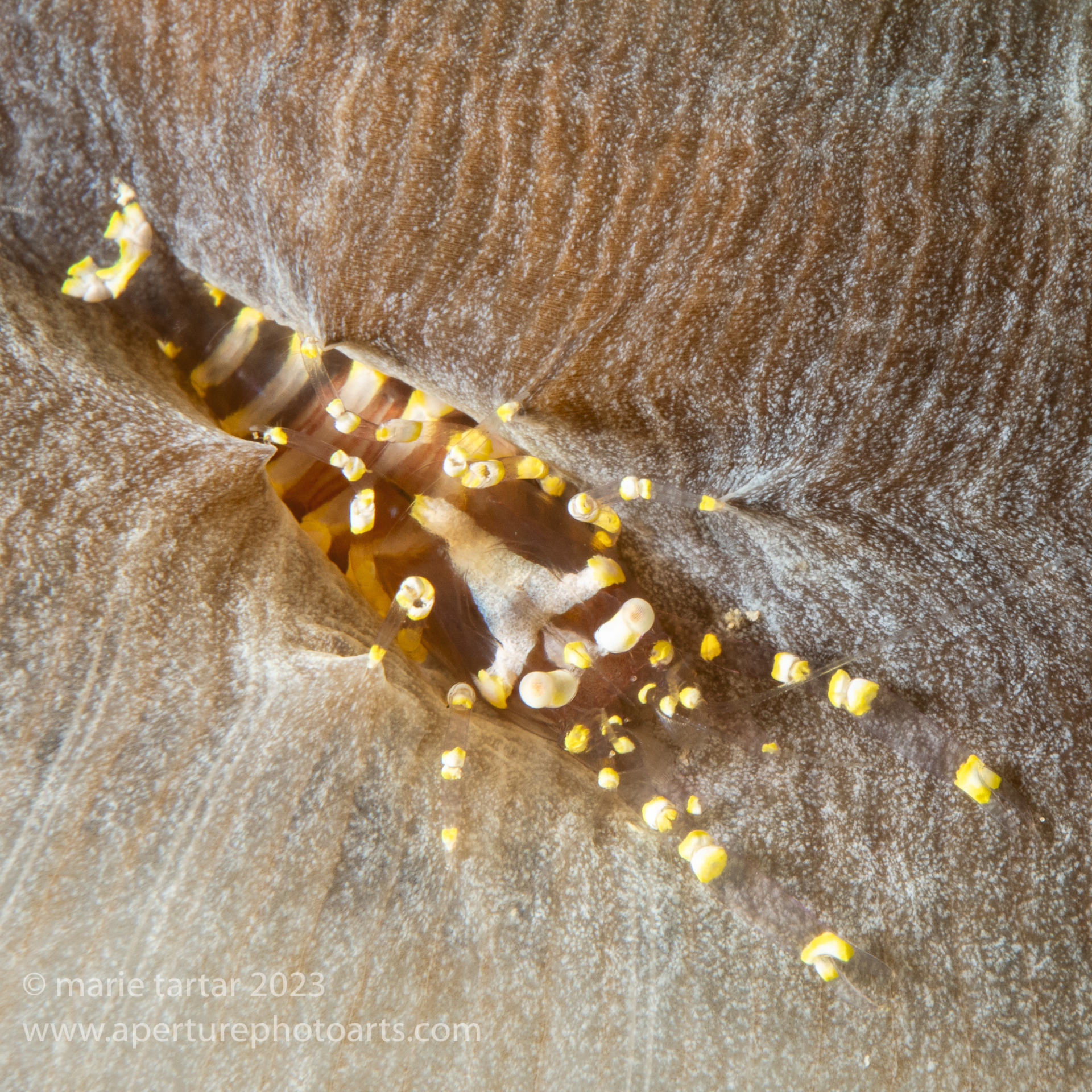
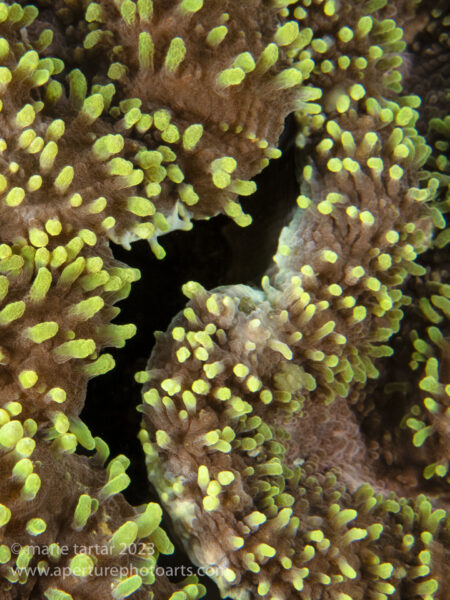
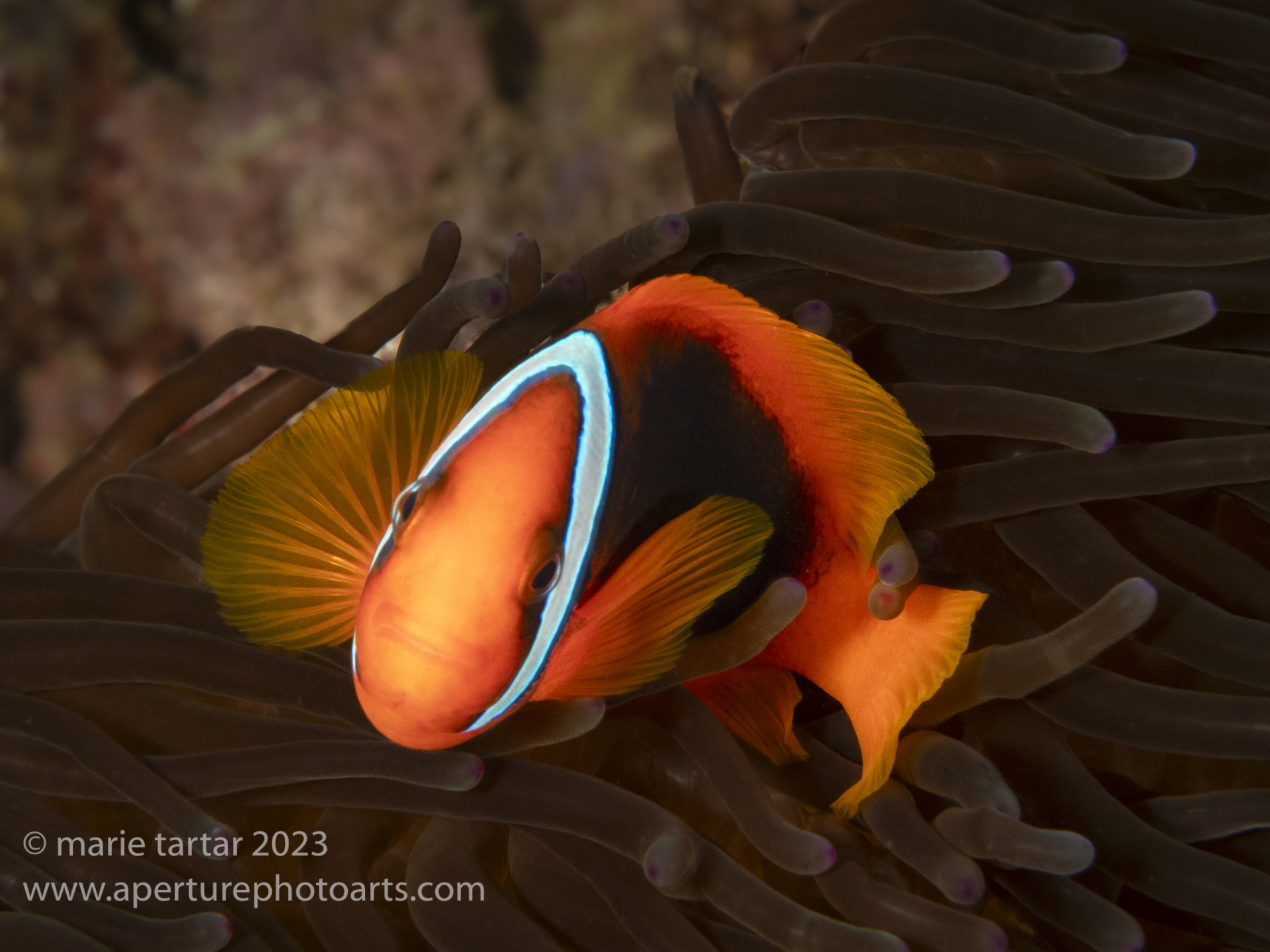
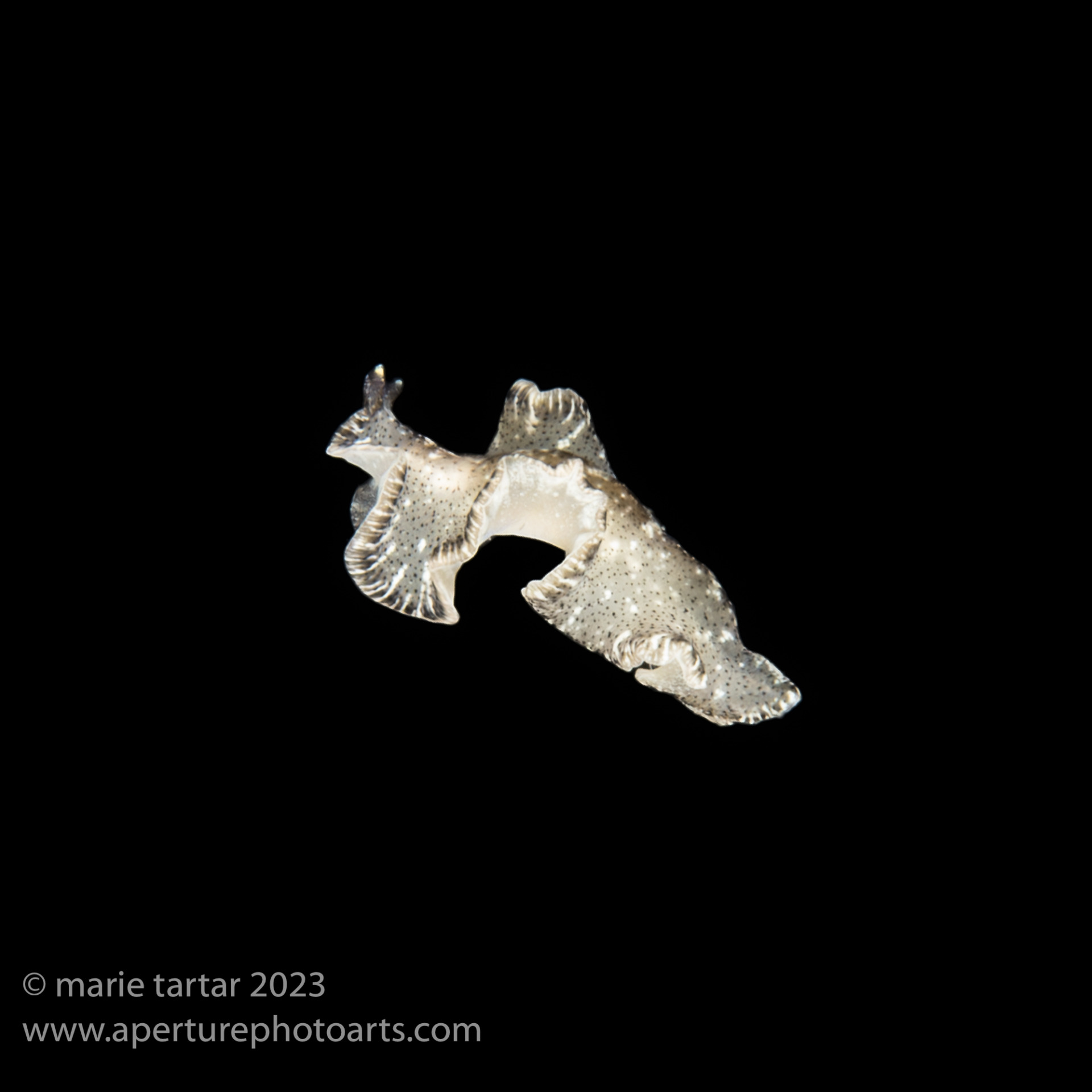
Second attempt (the first time I tried to say how spectacular and fun to read this was WordPress told me what I had written was spam). Spectacular–also fun to read! (Let’s see if this skeletal version goes through.)